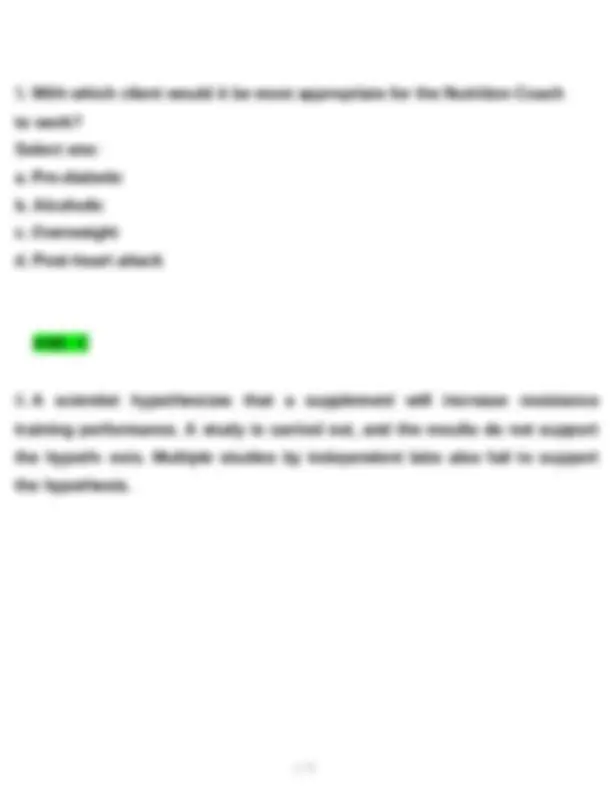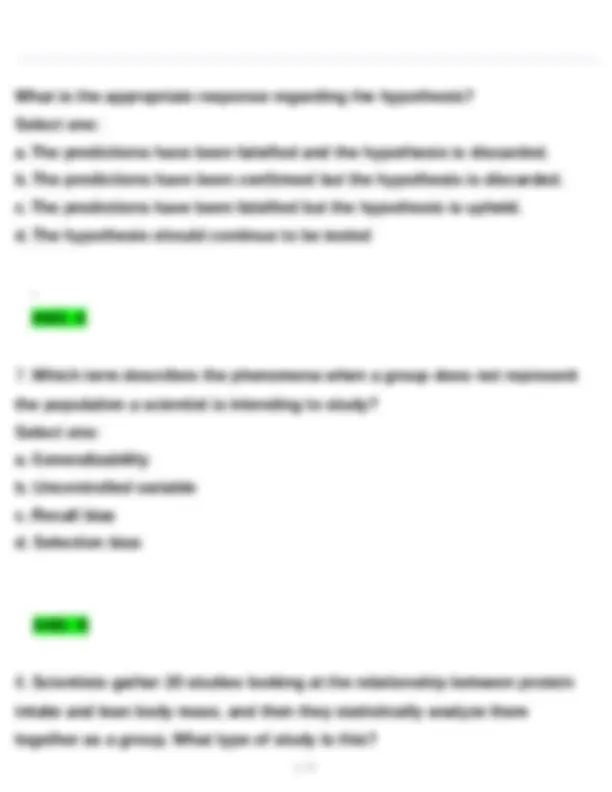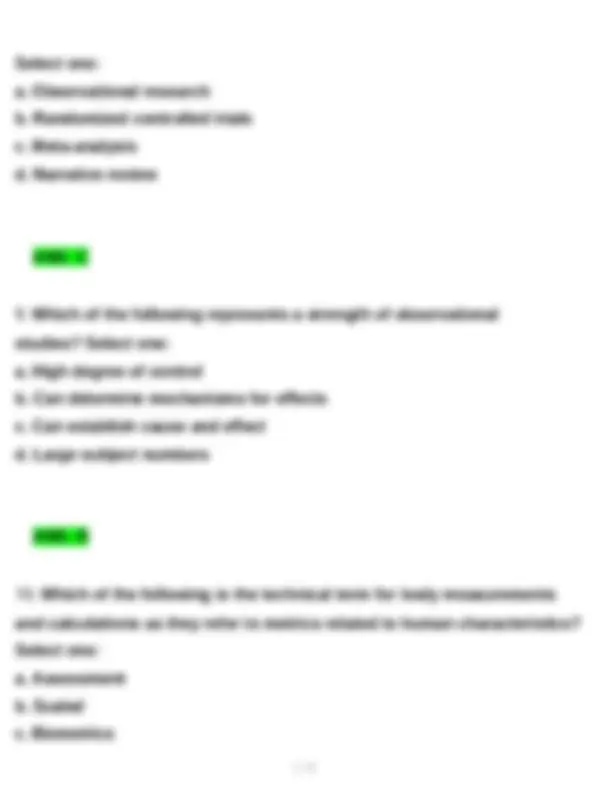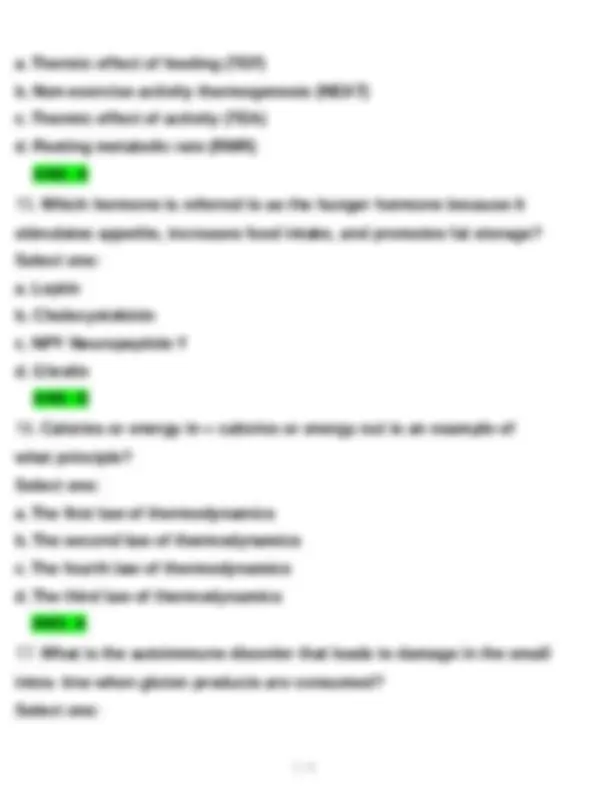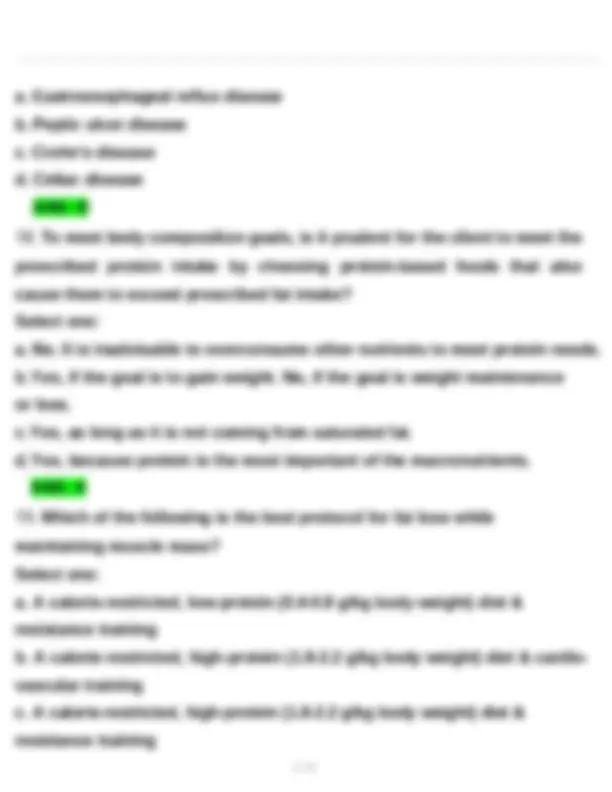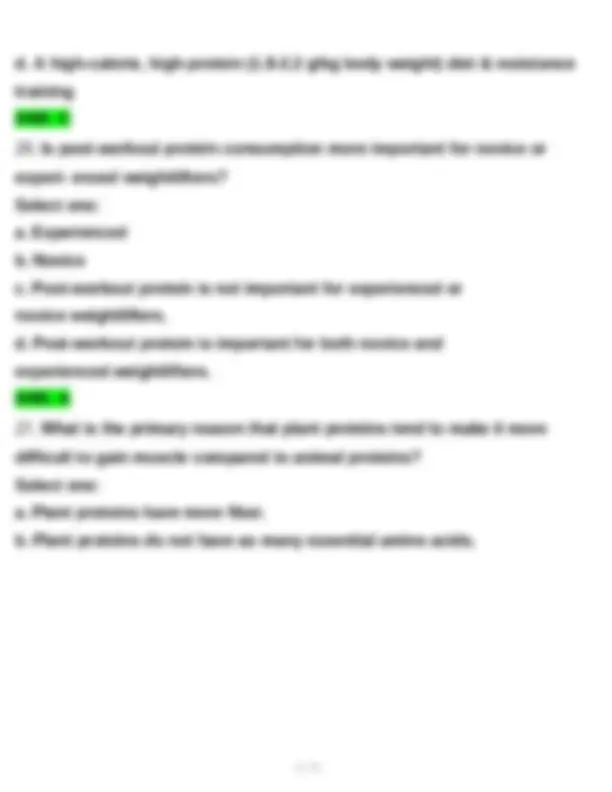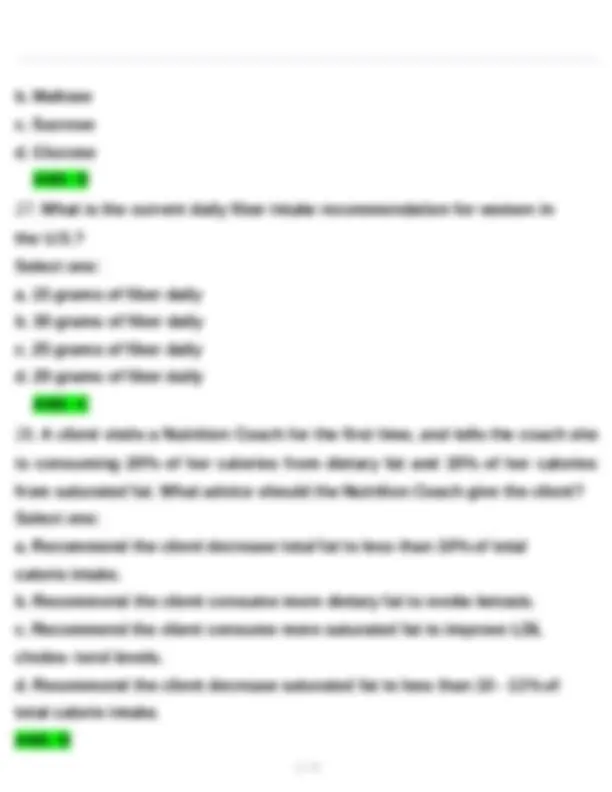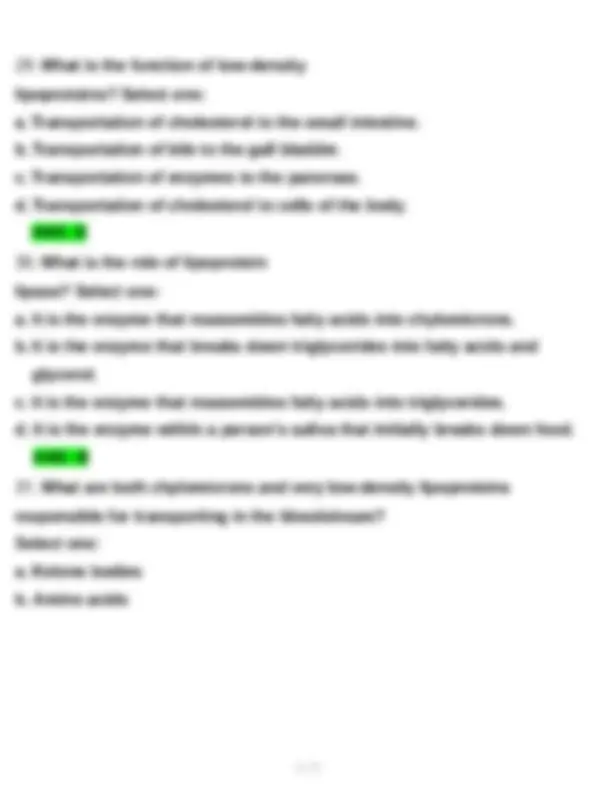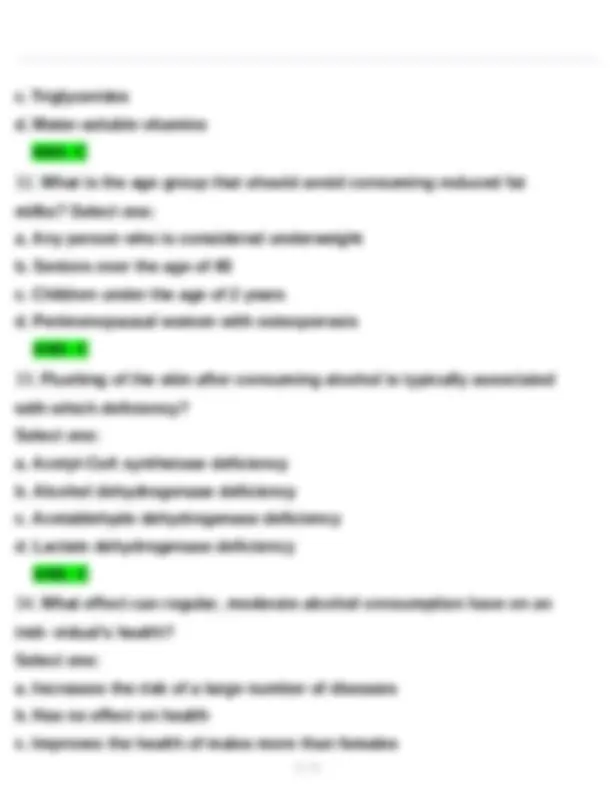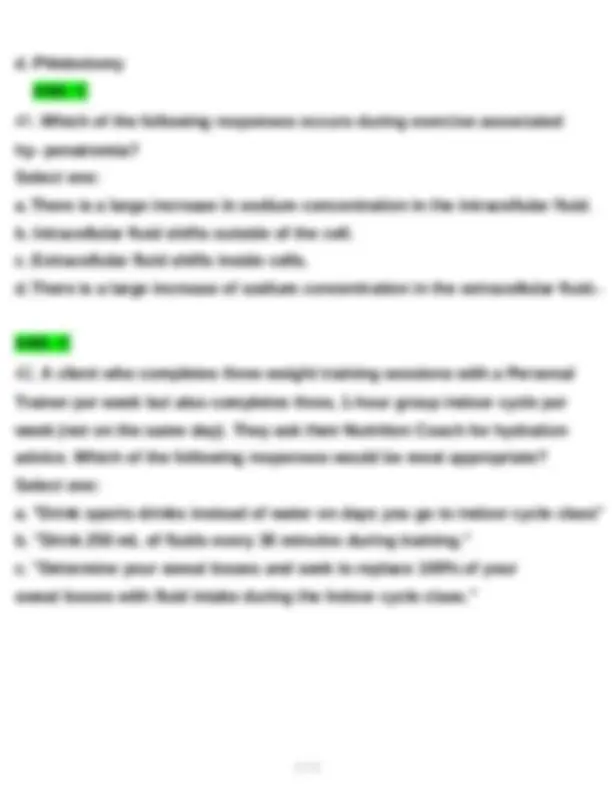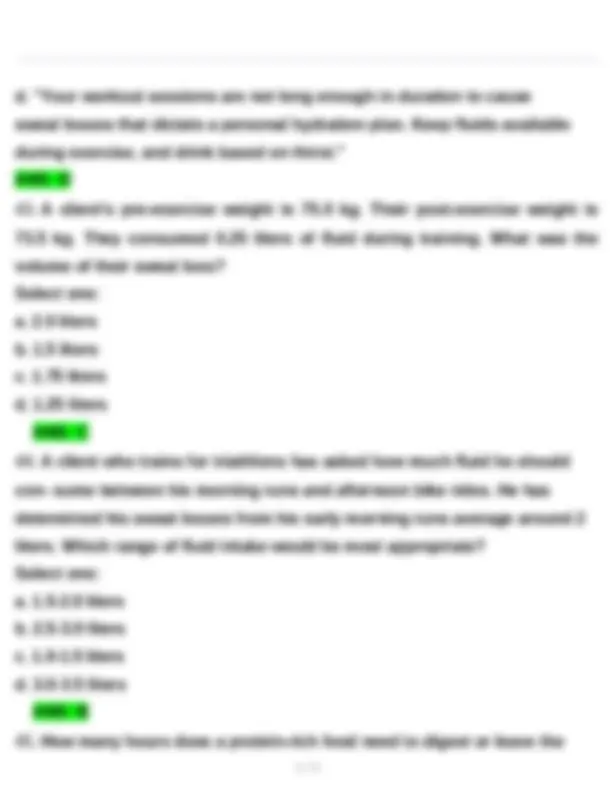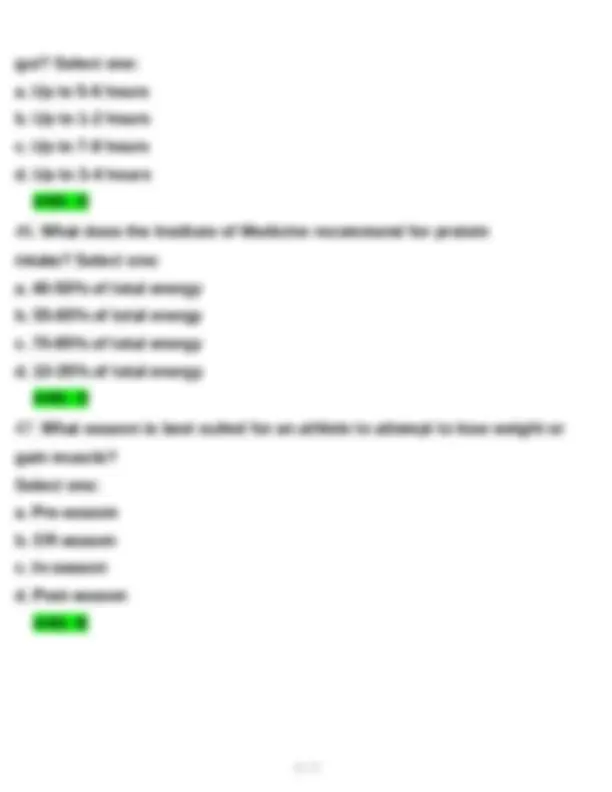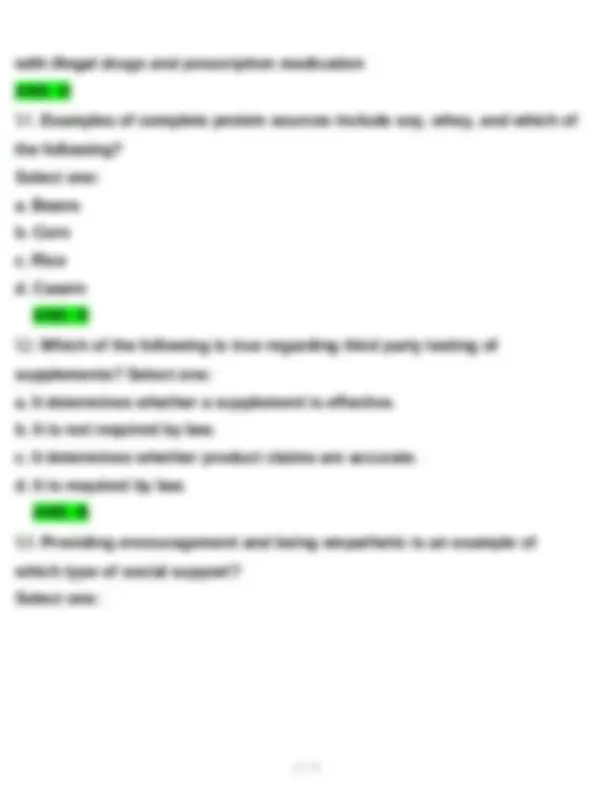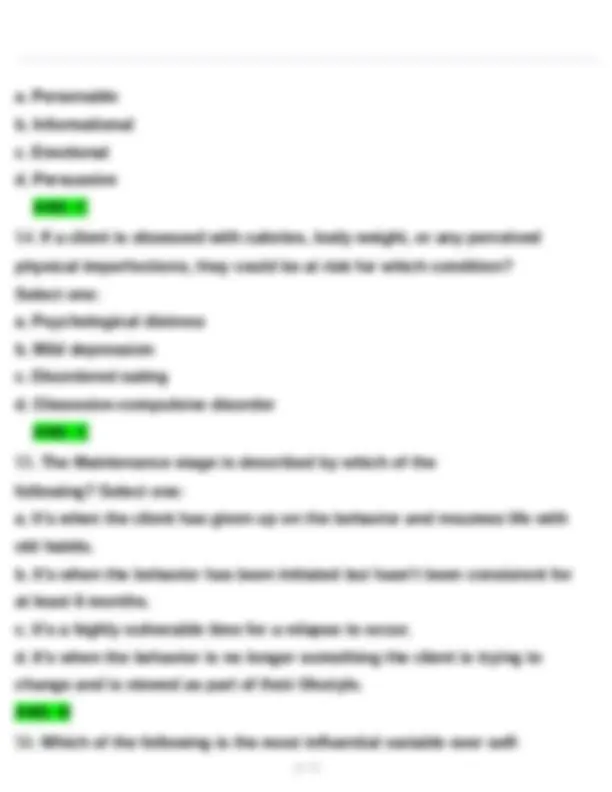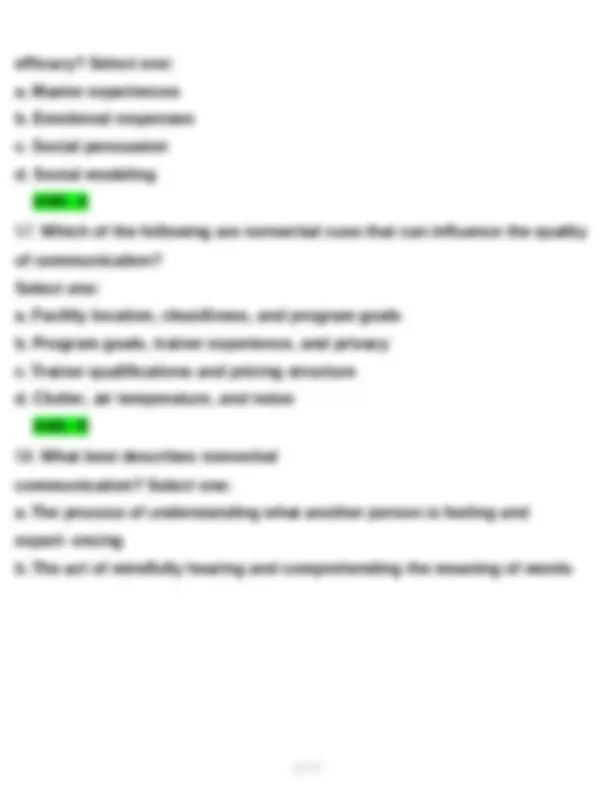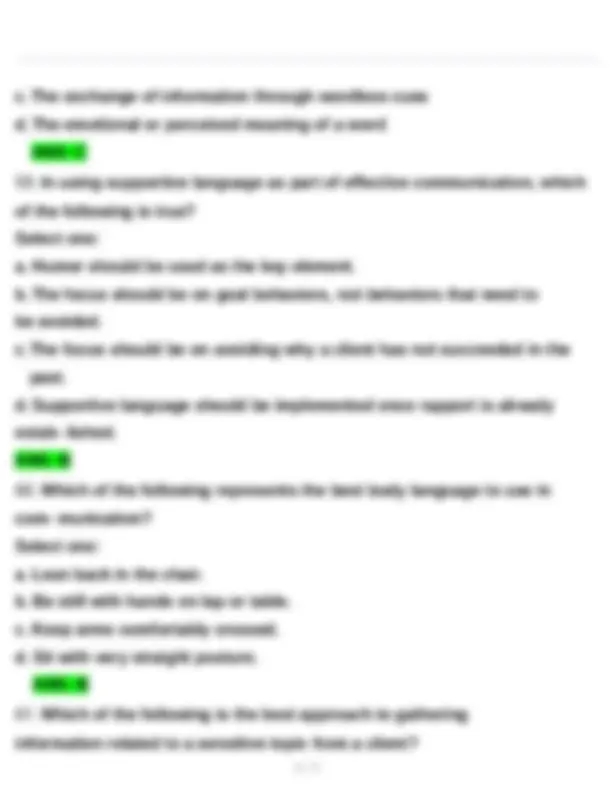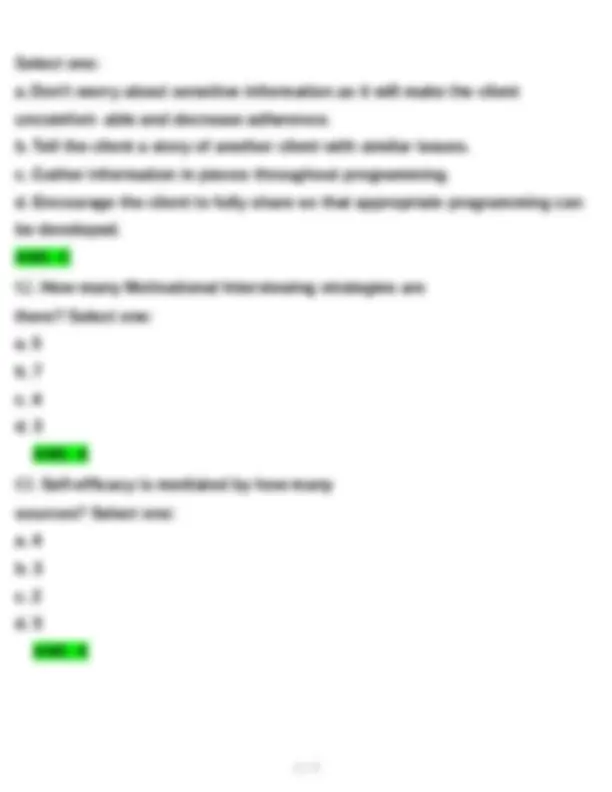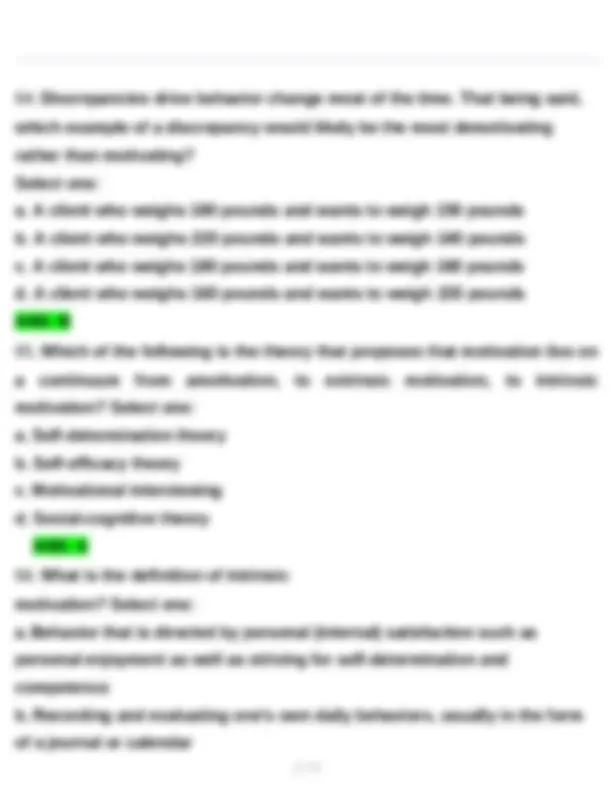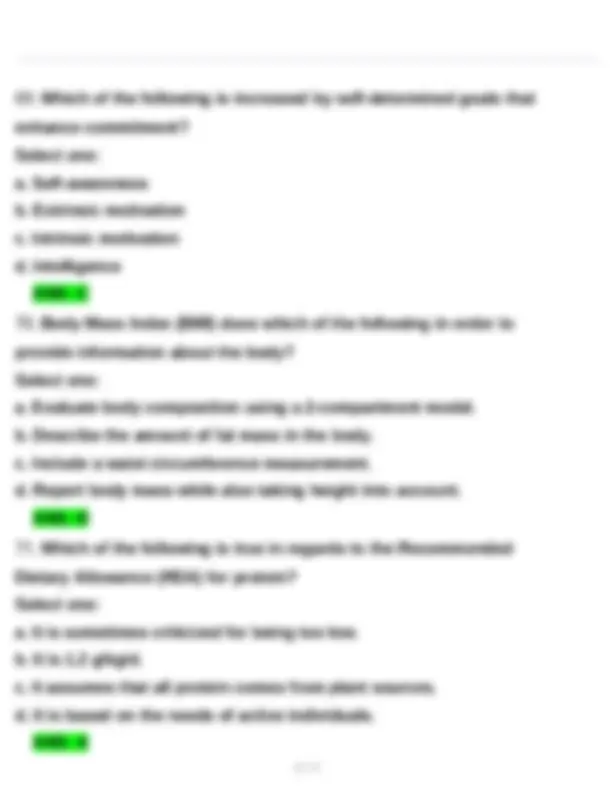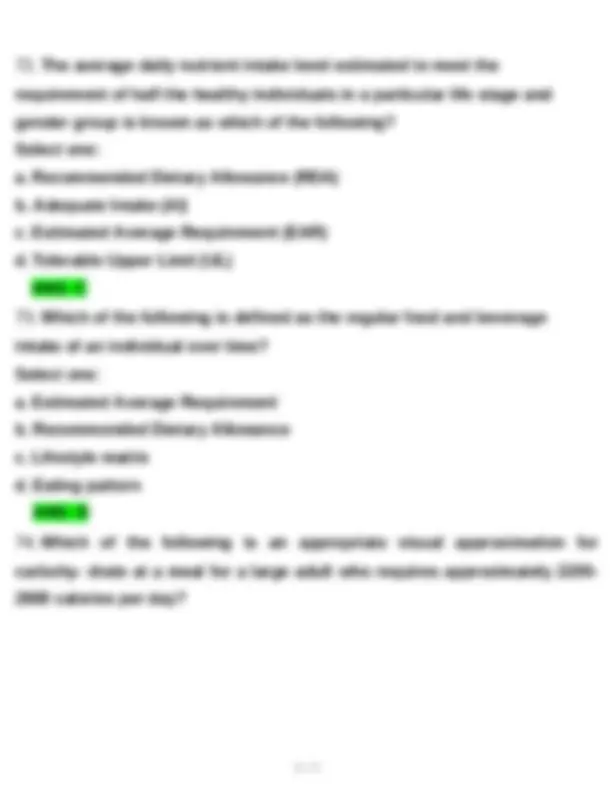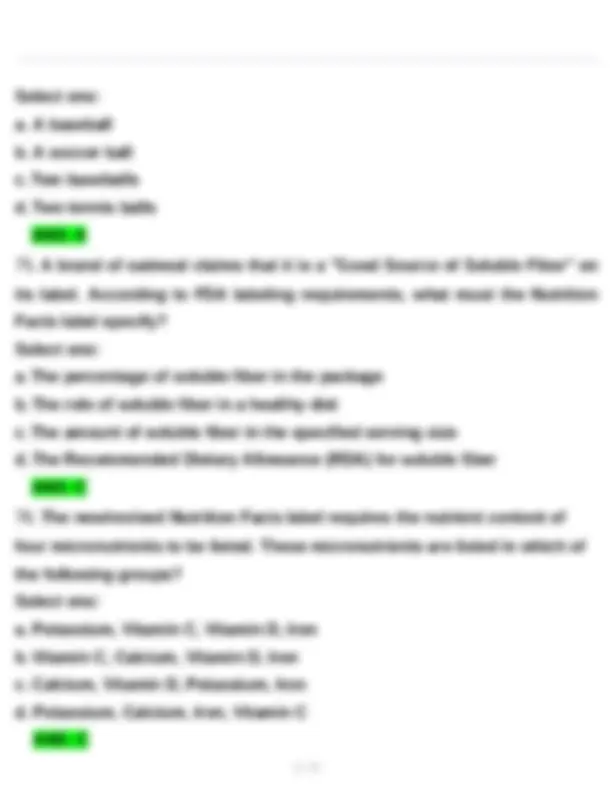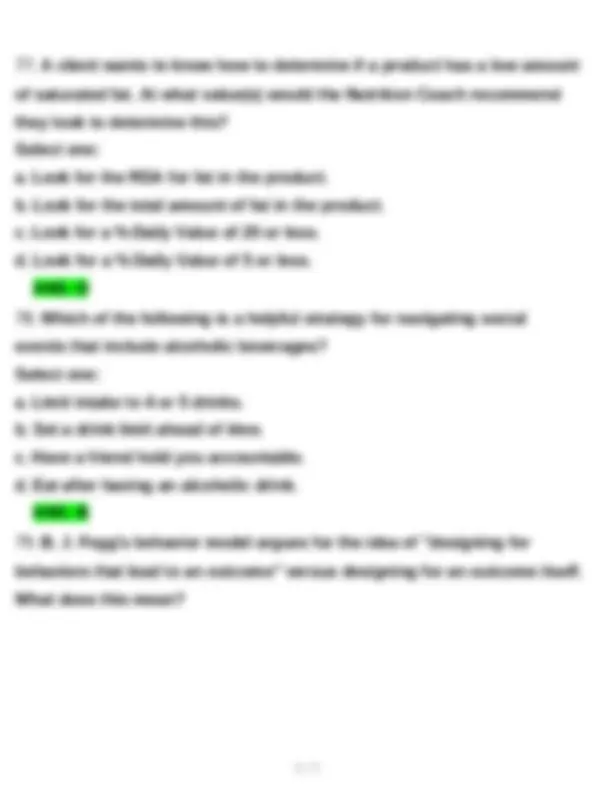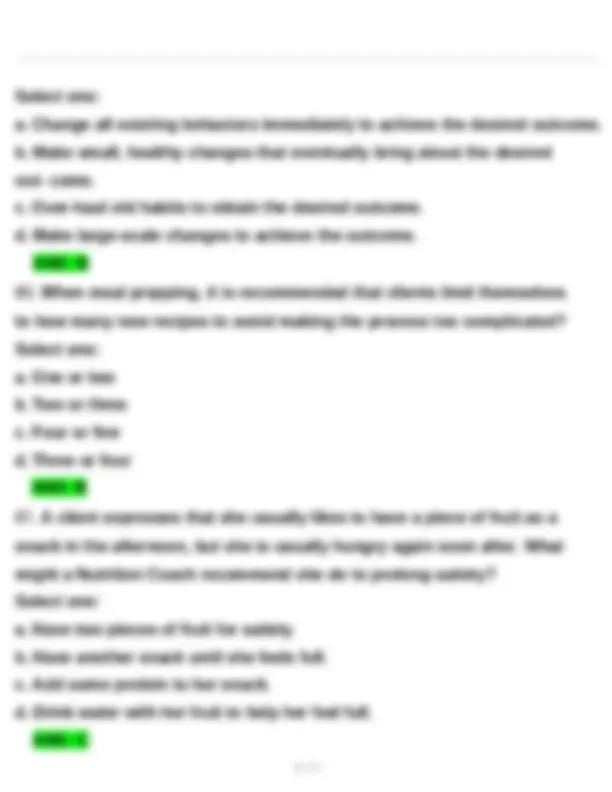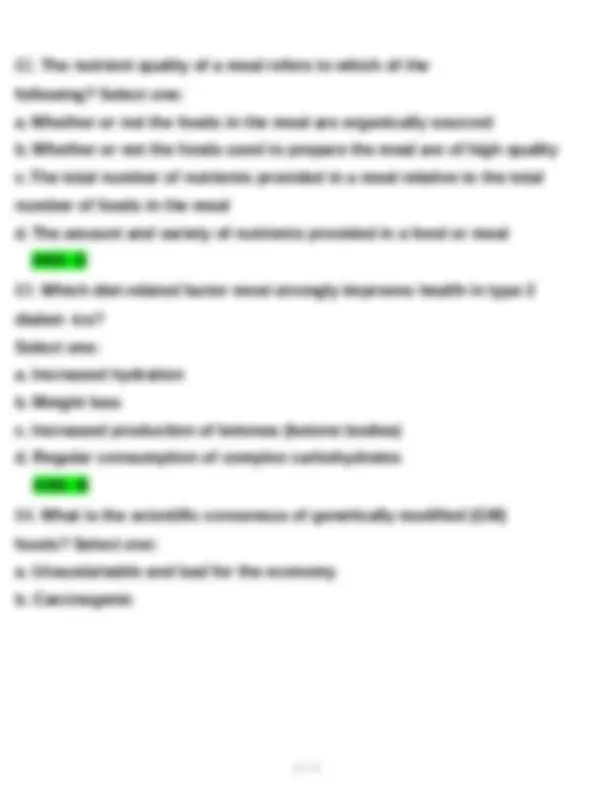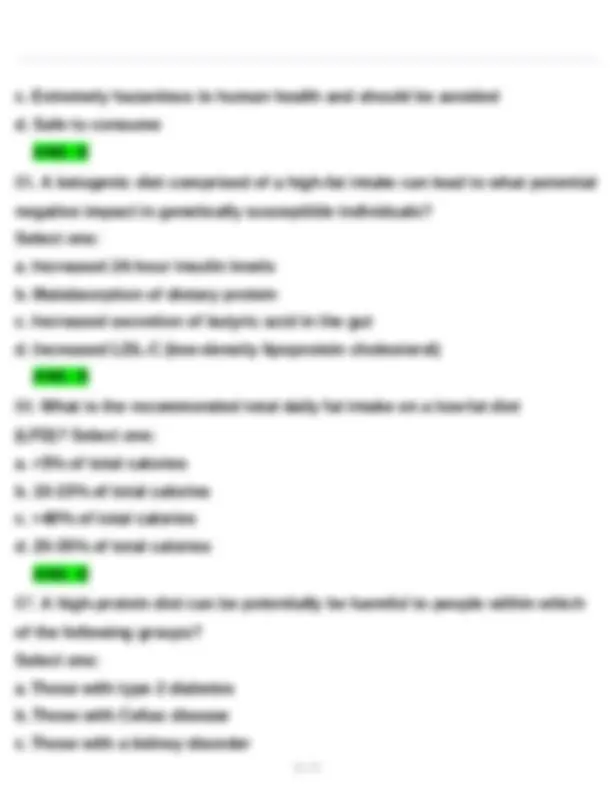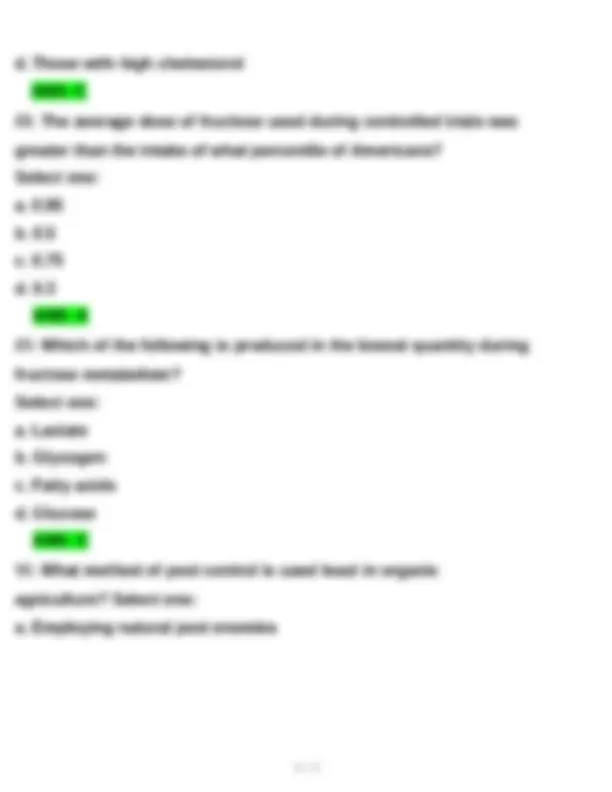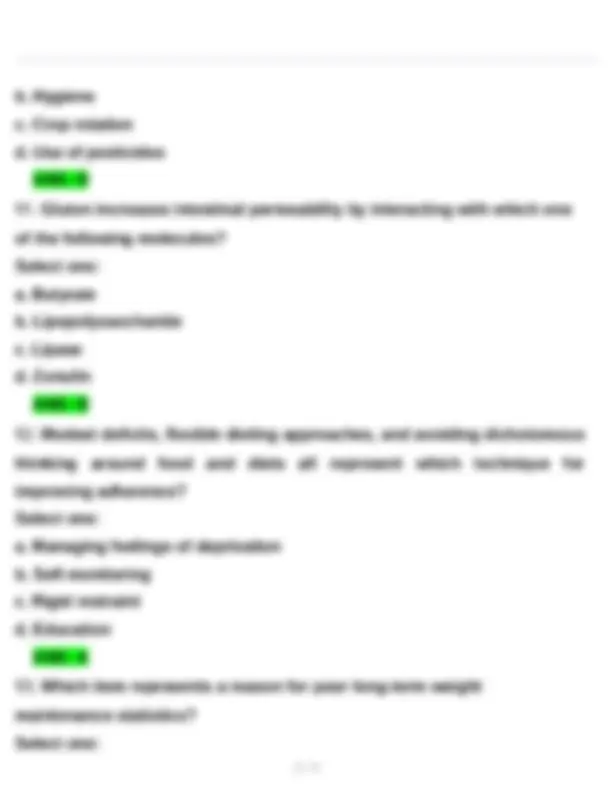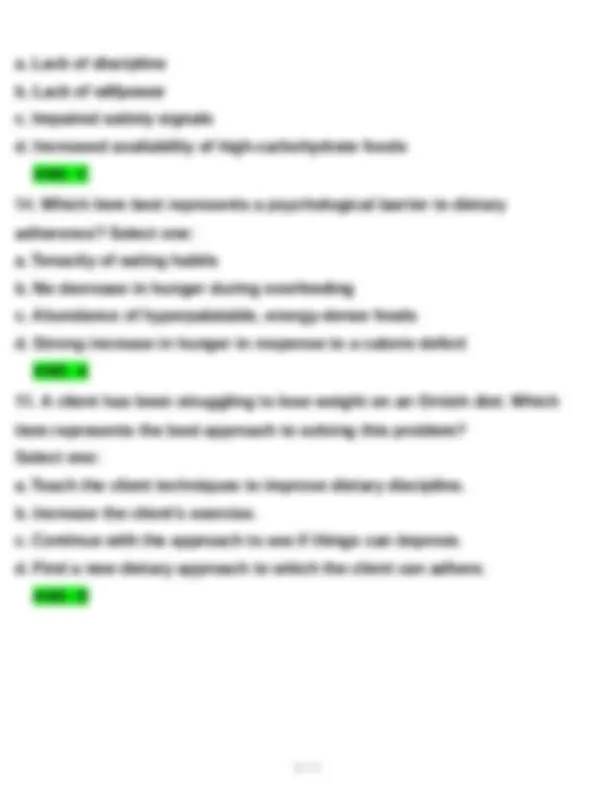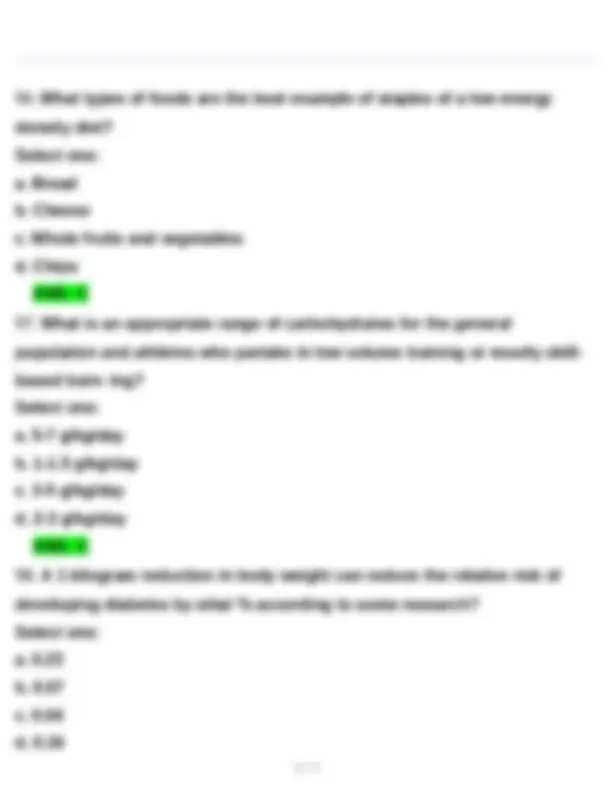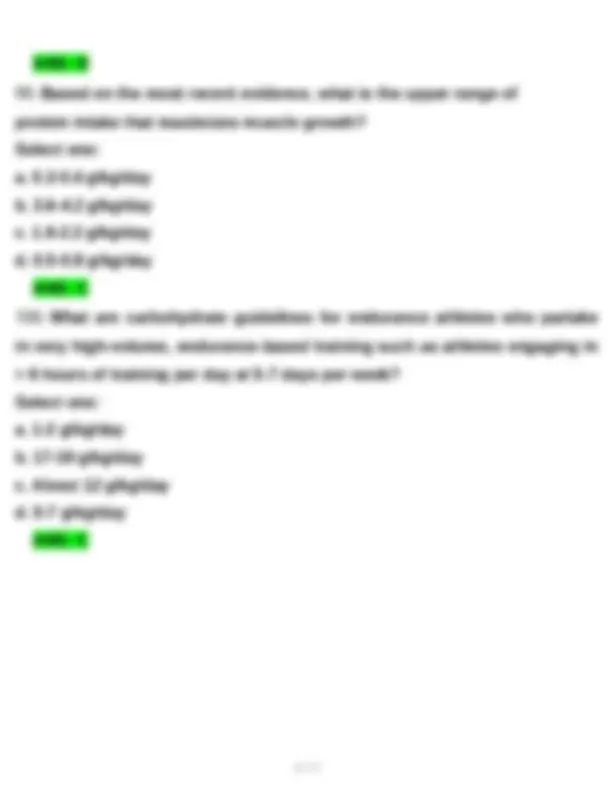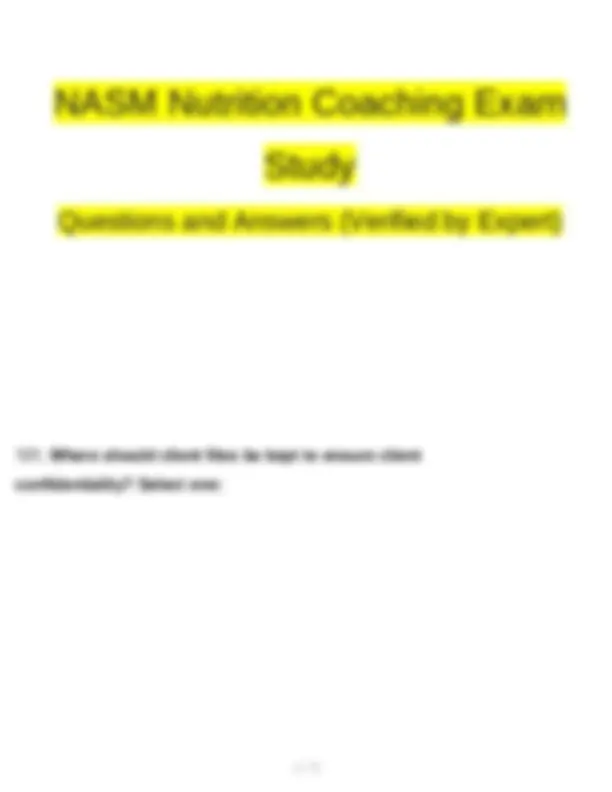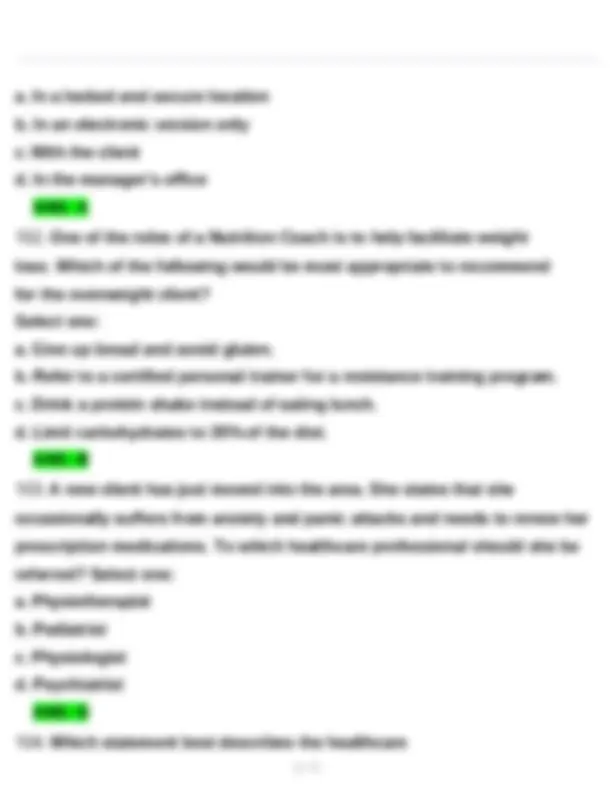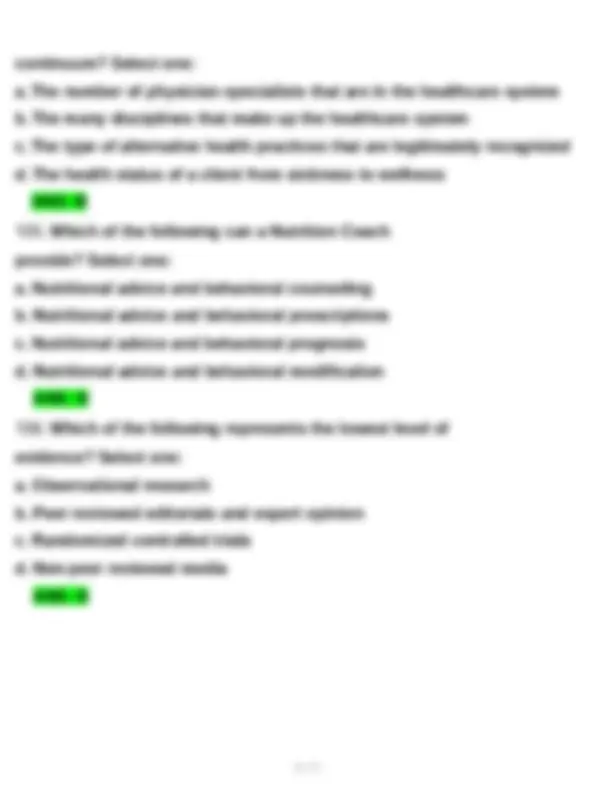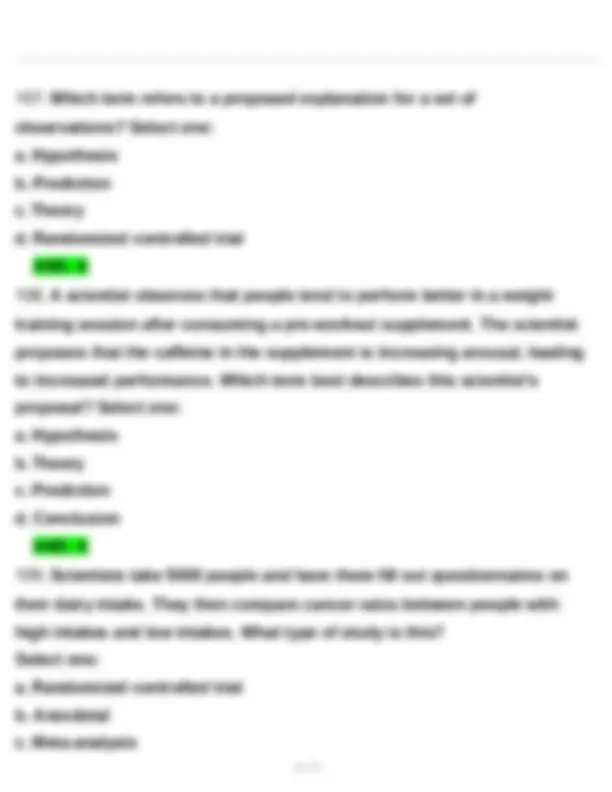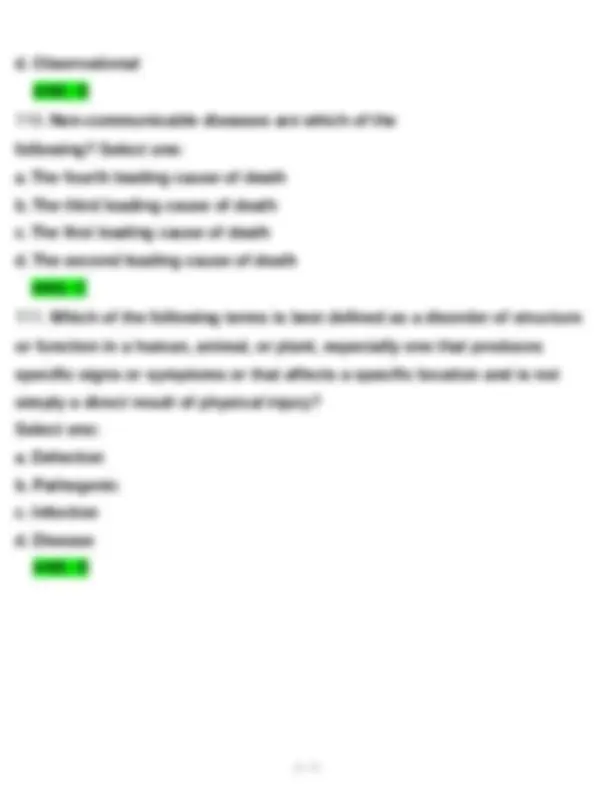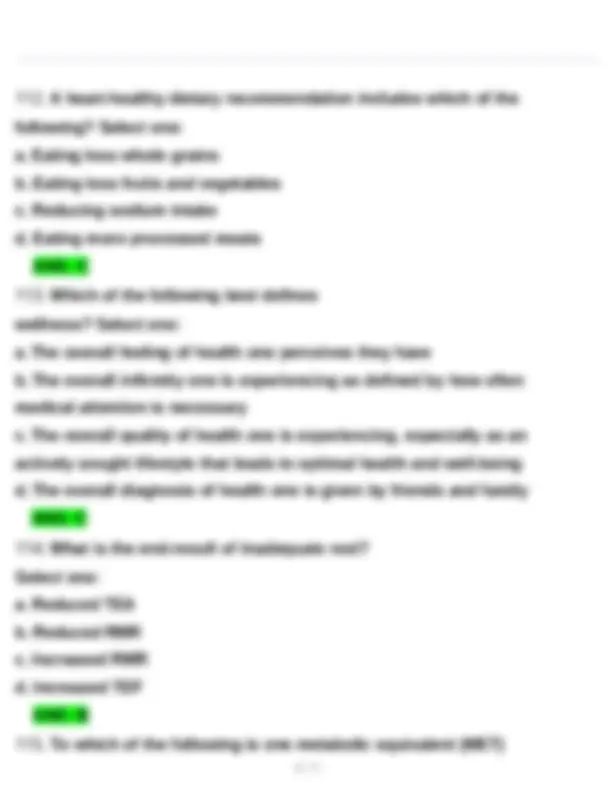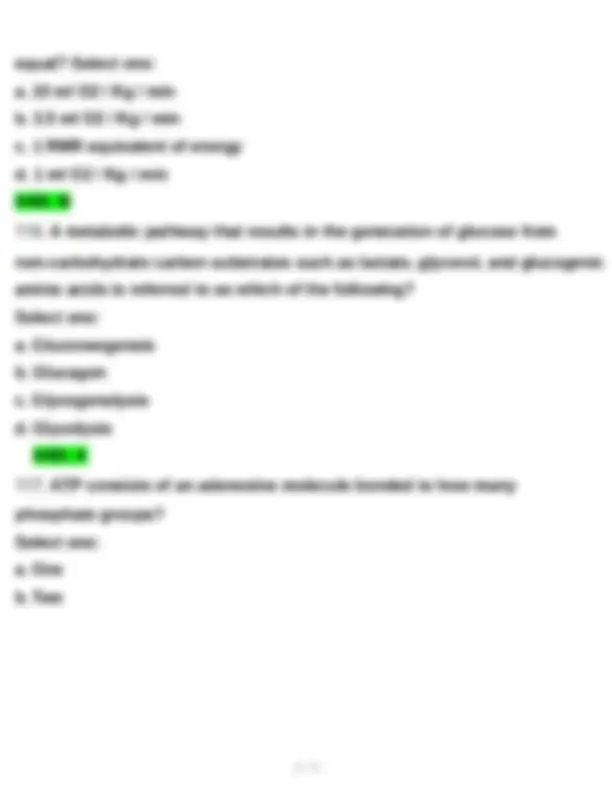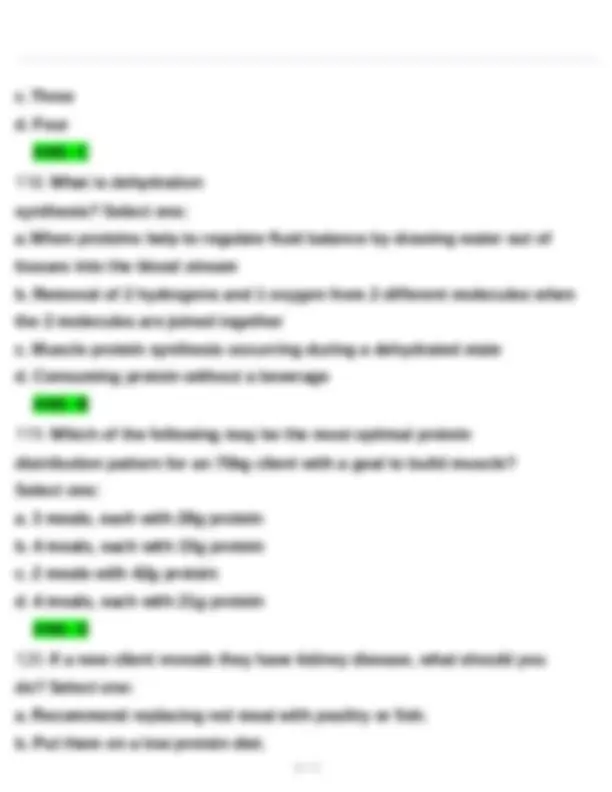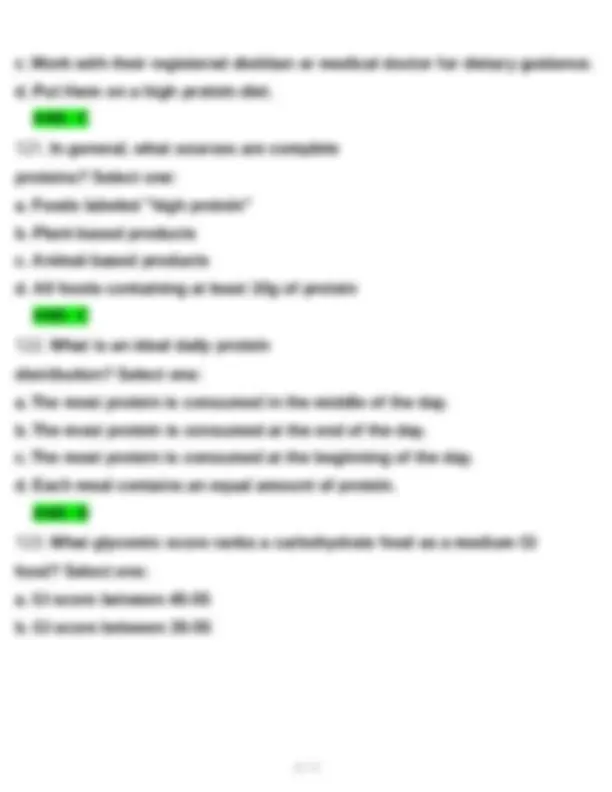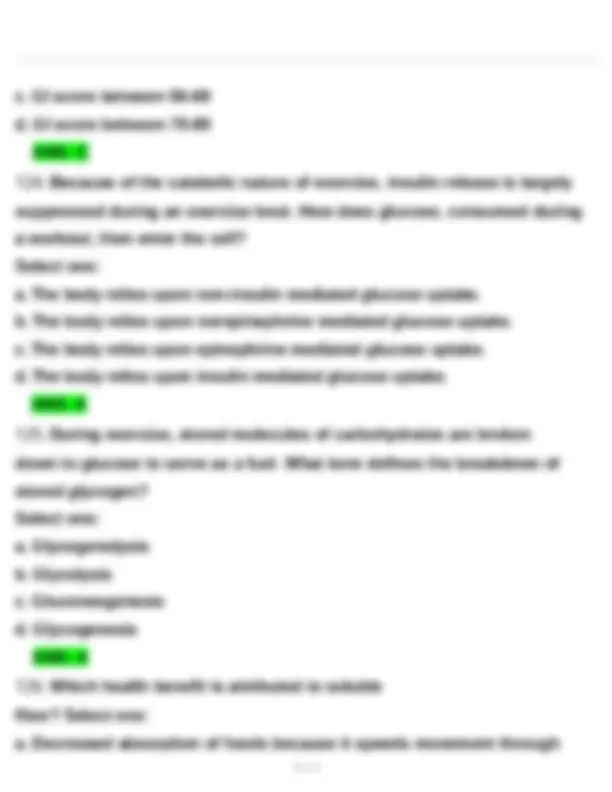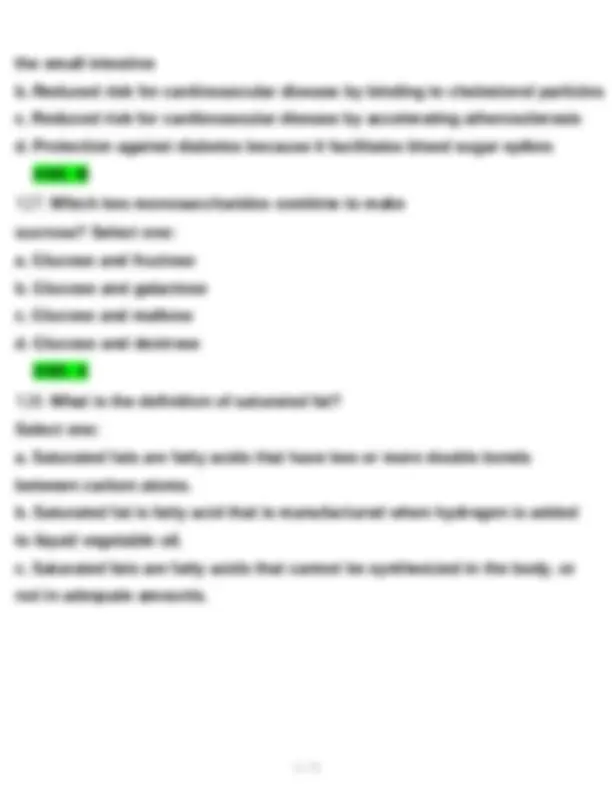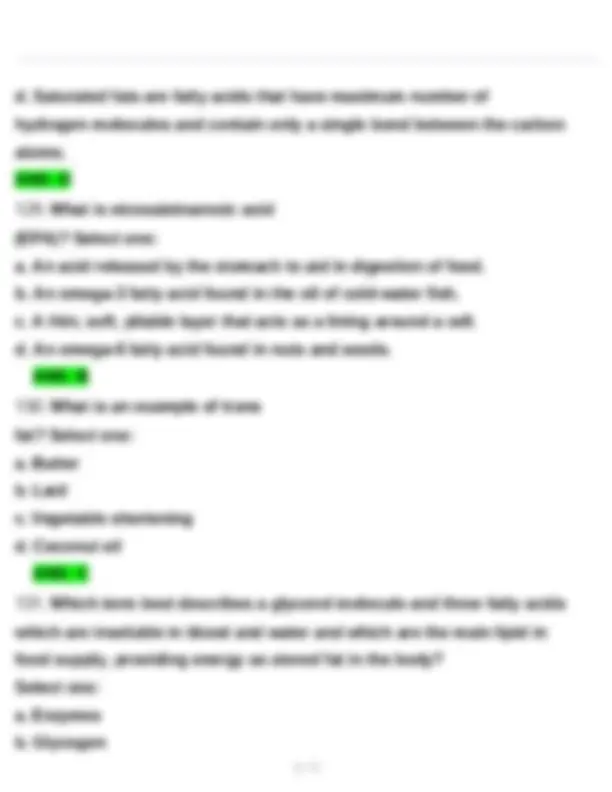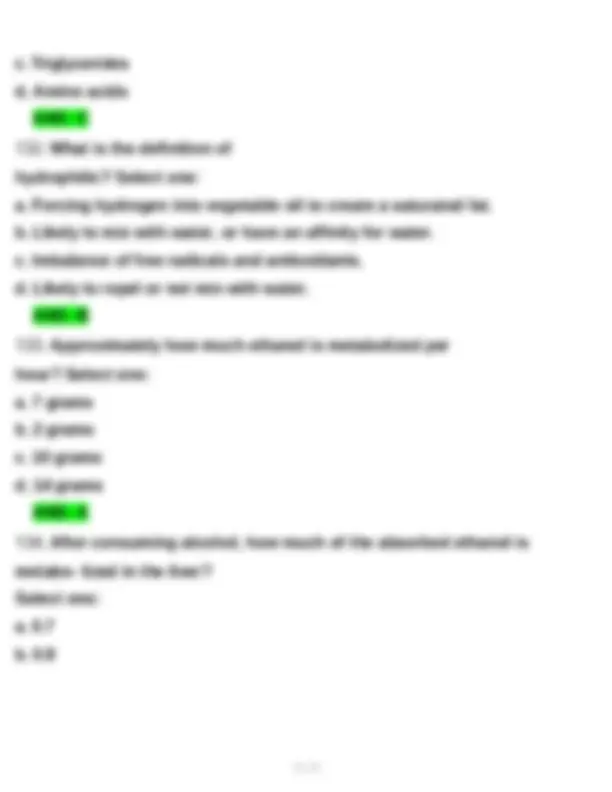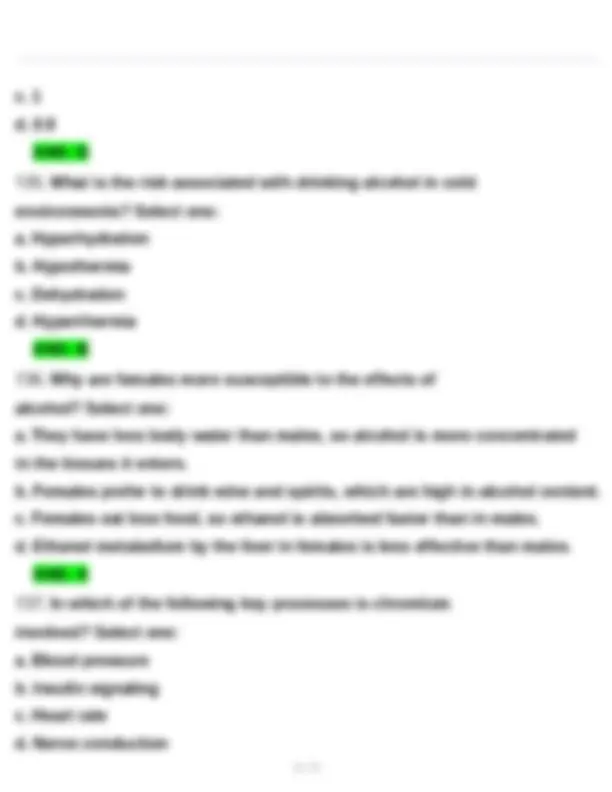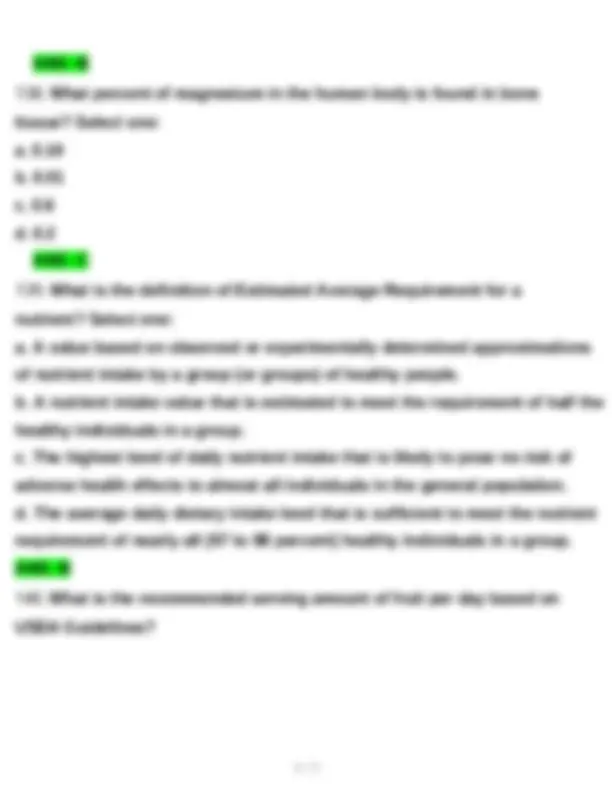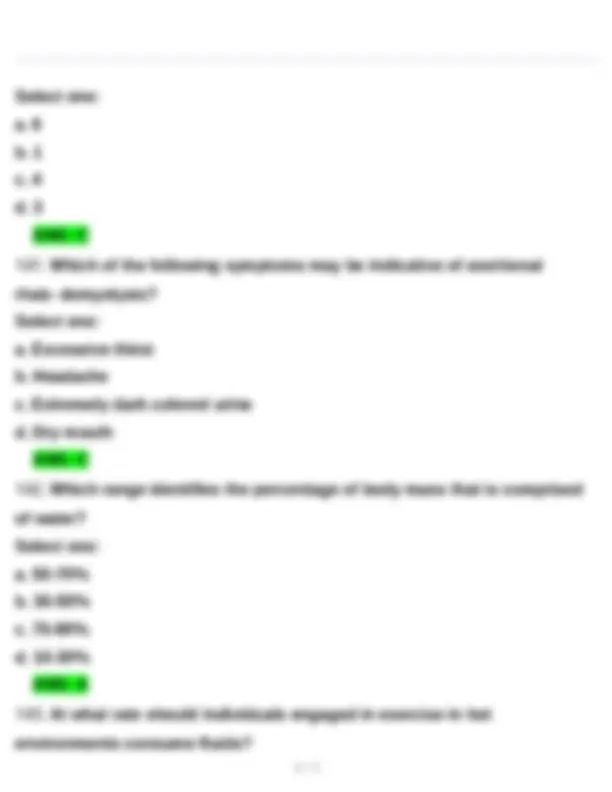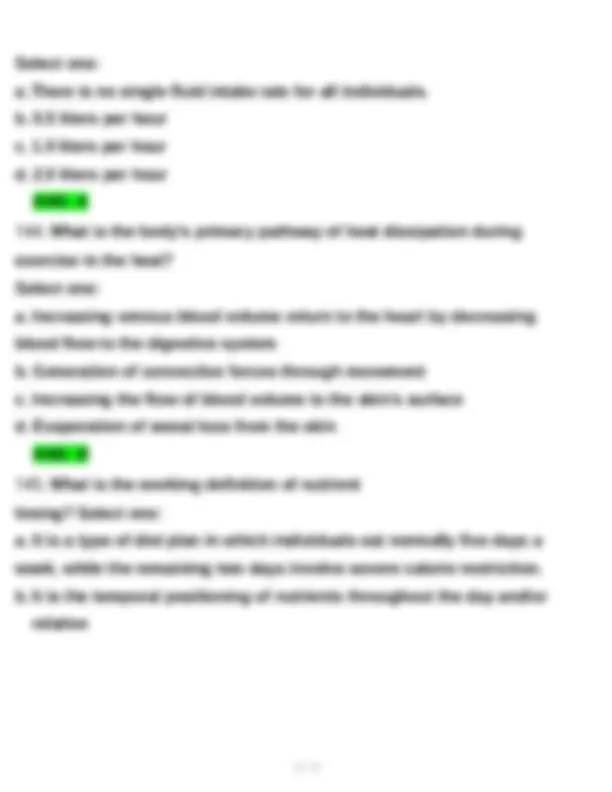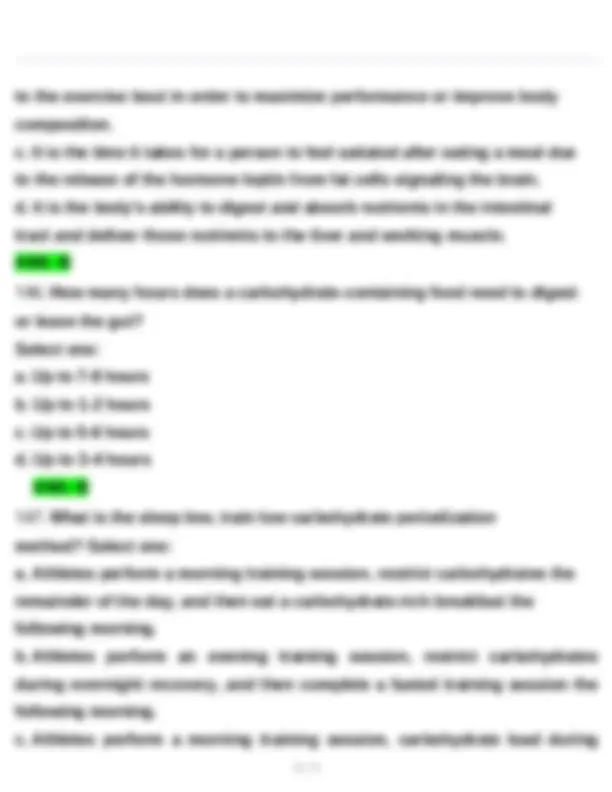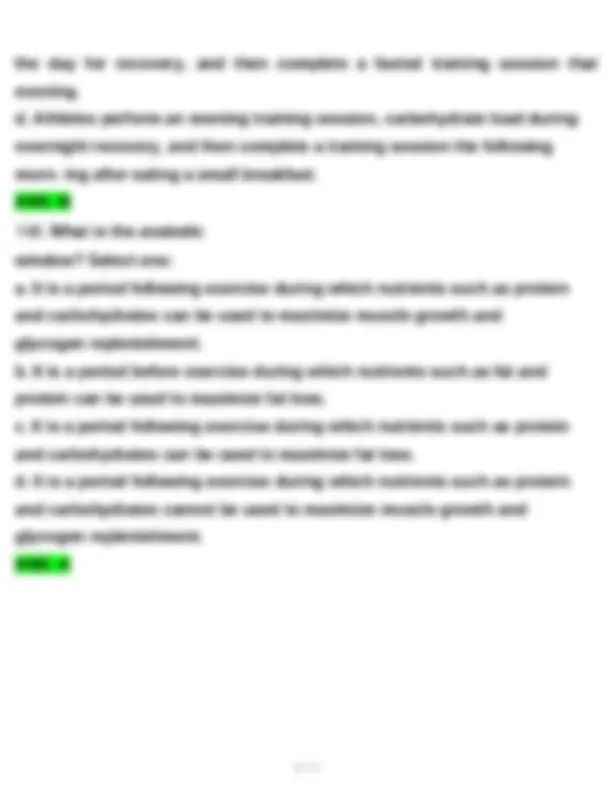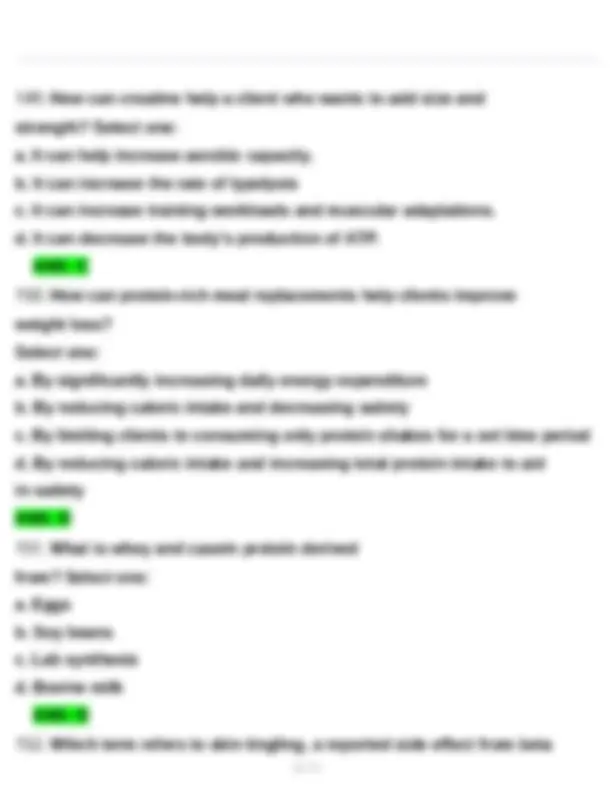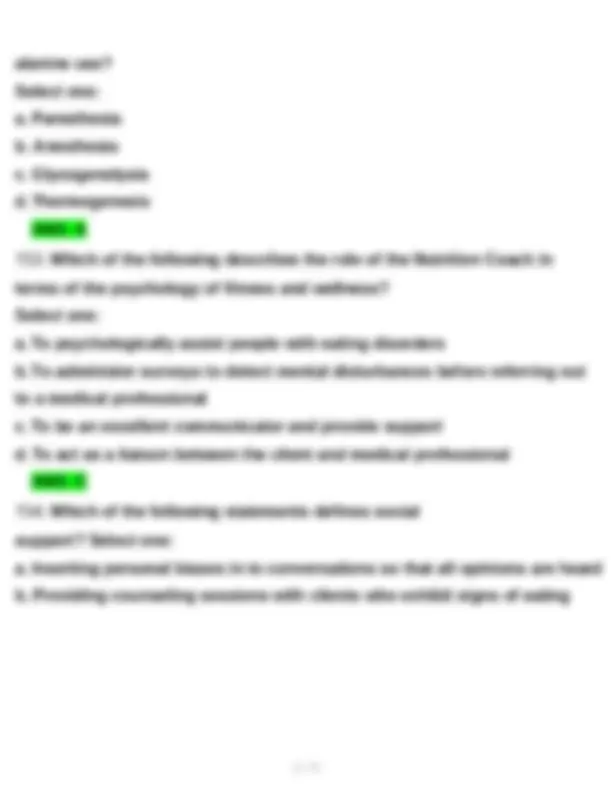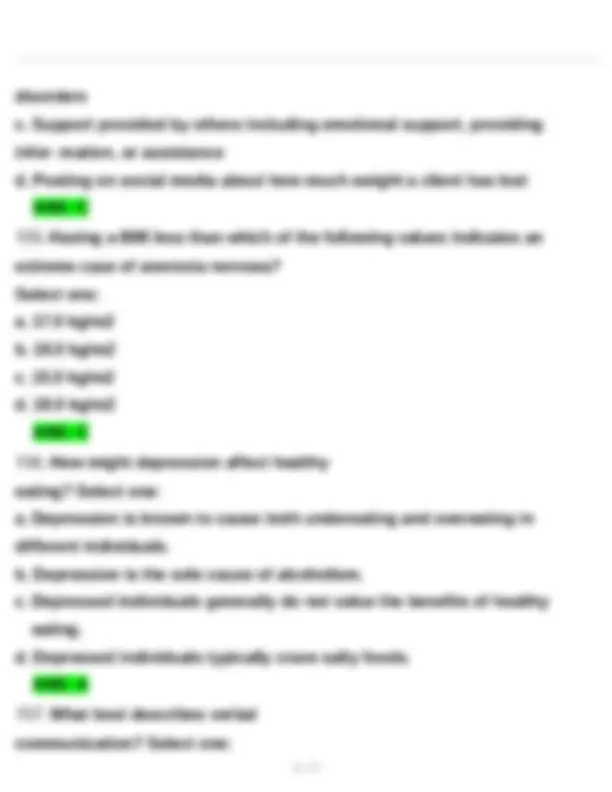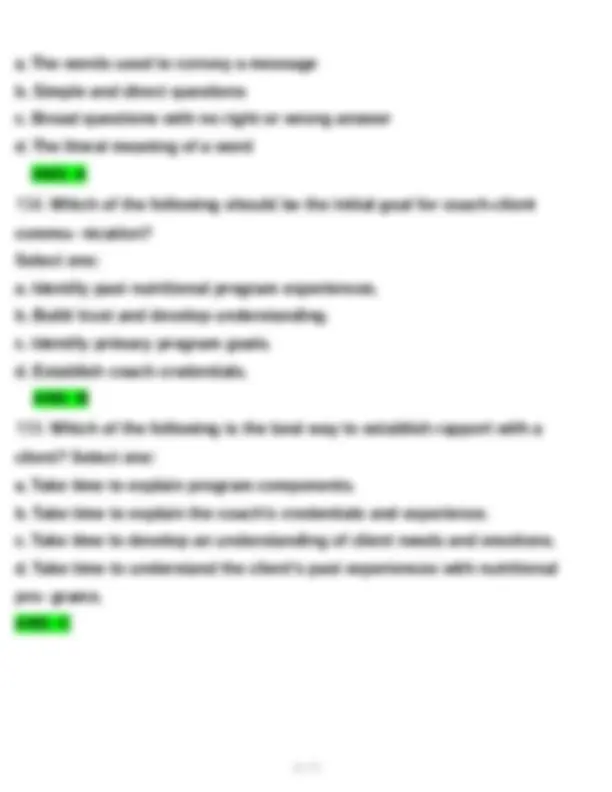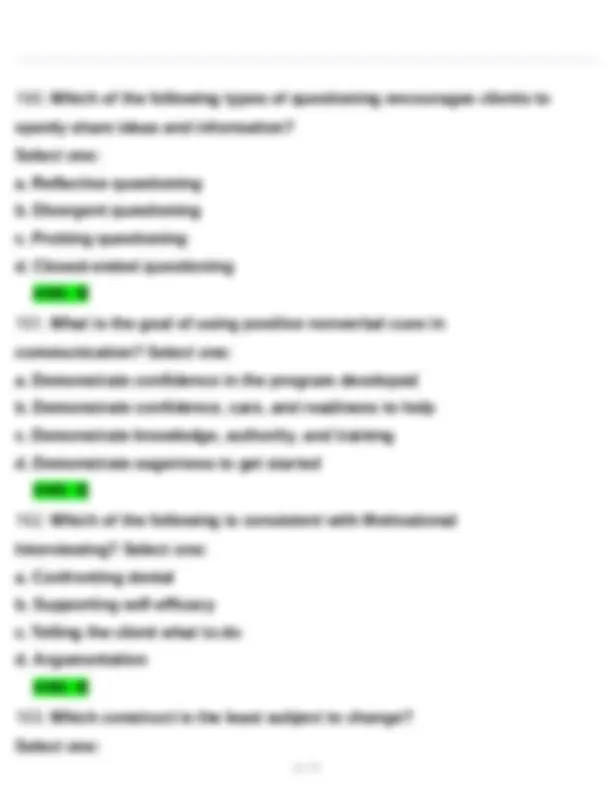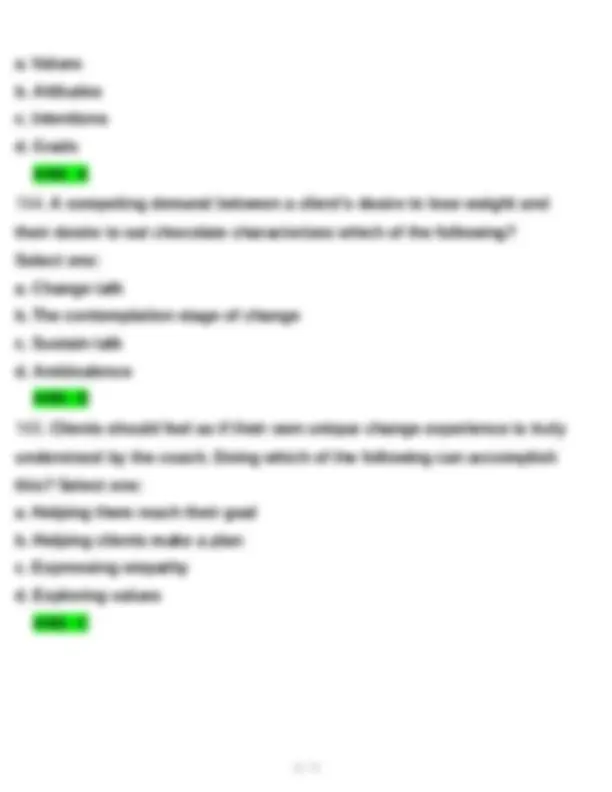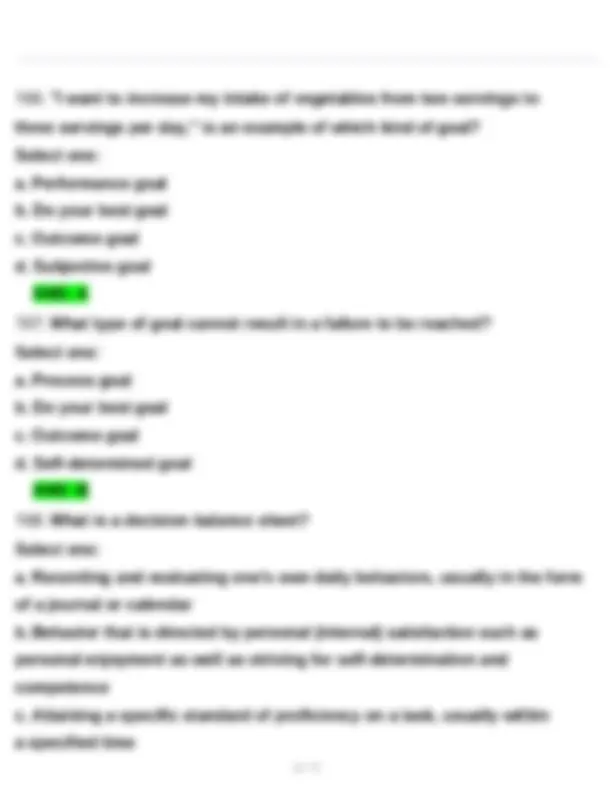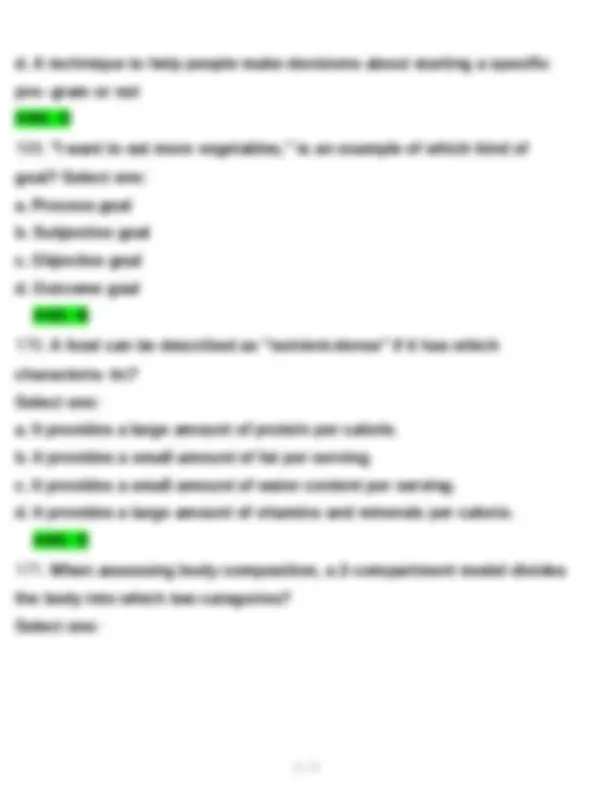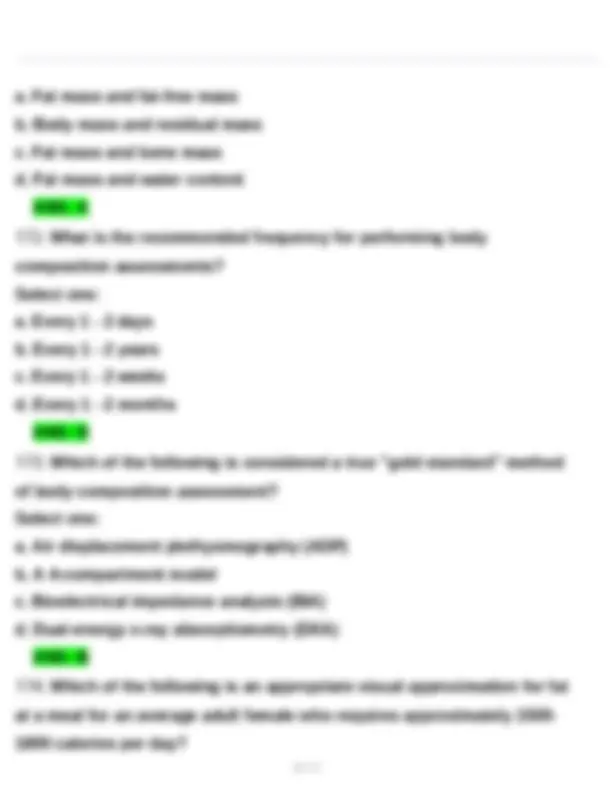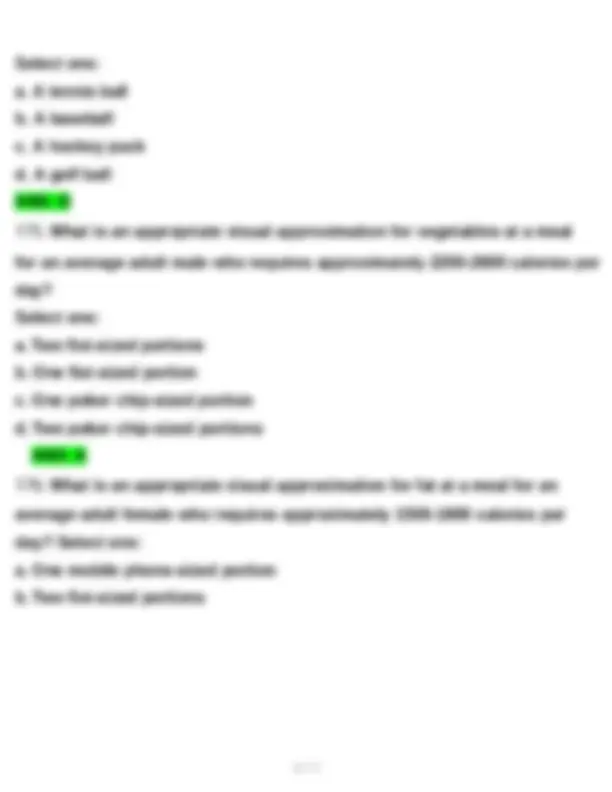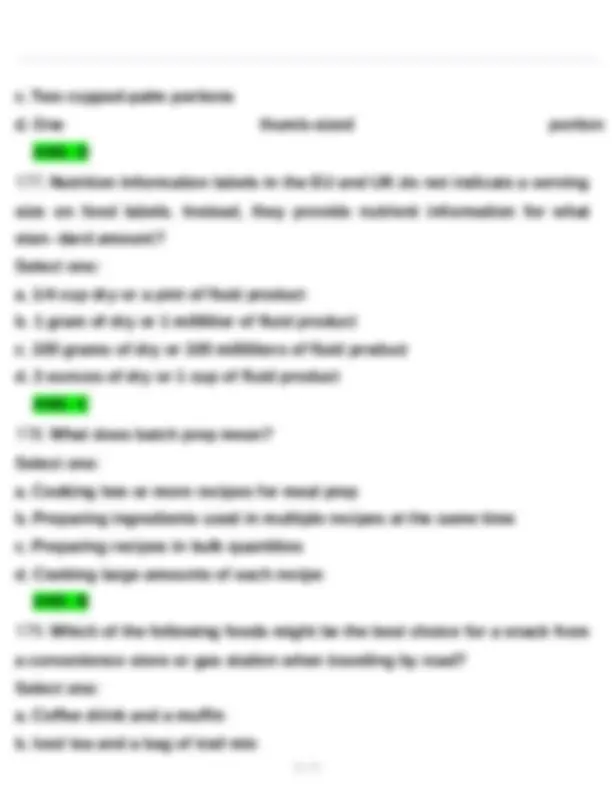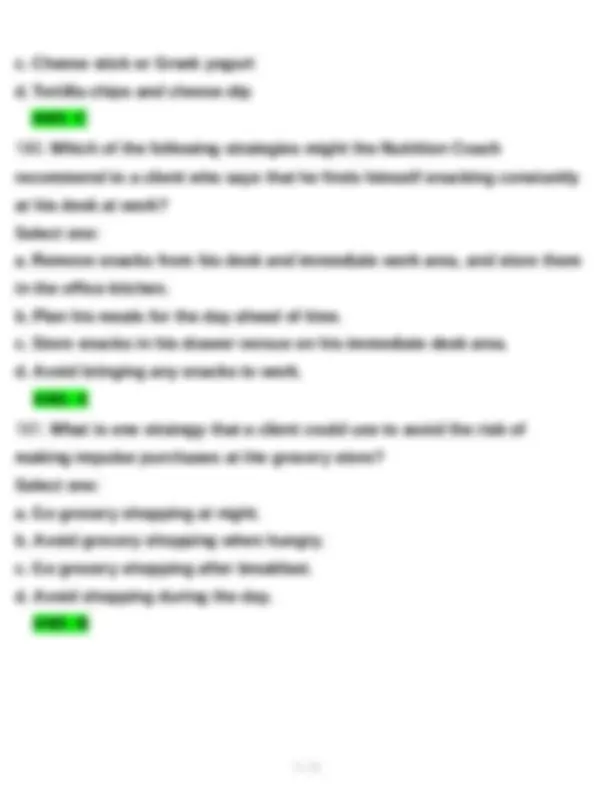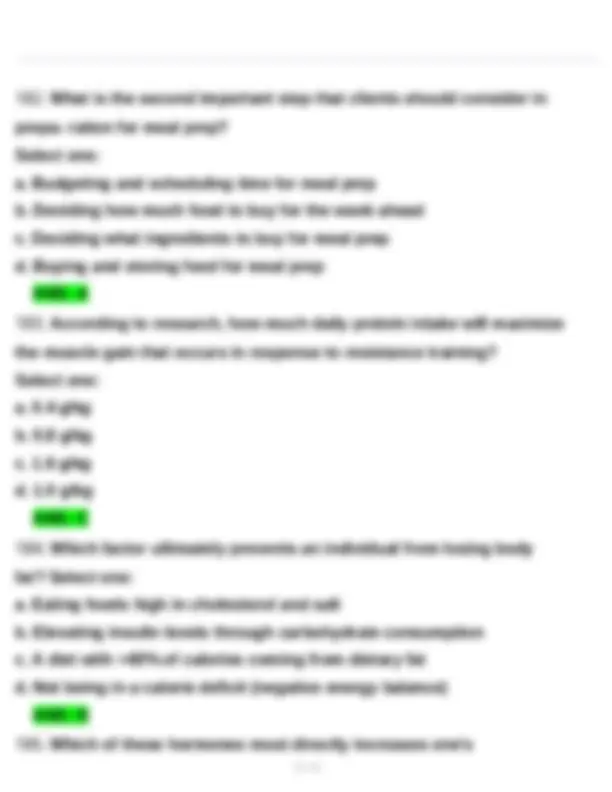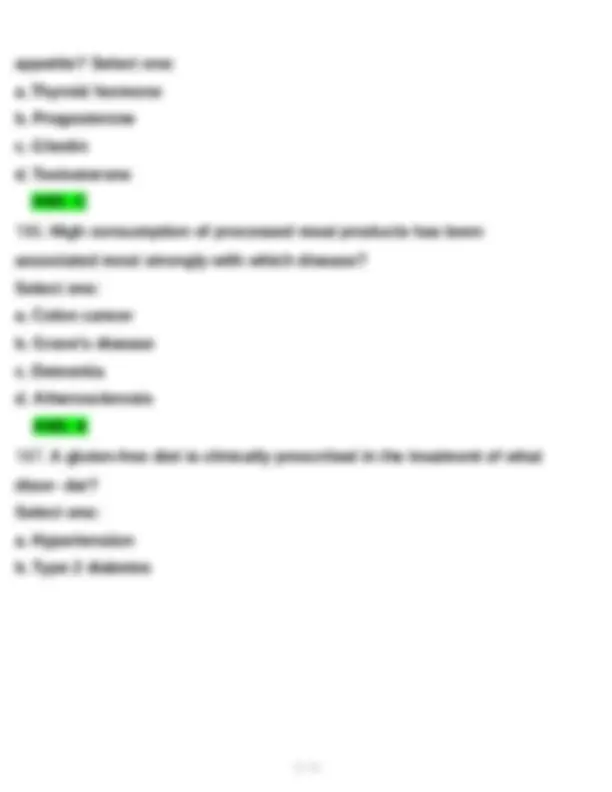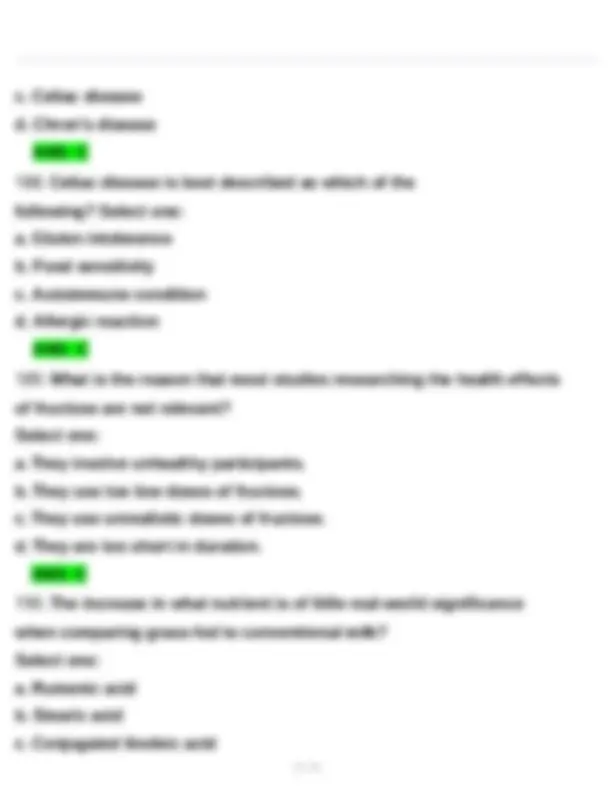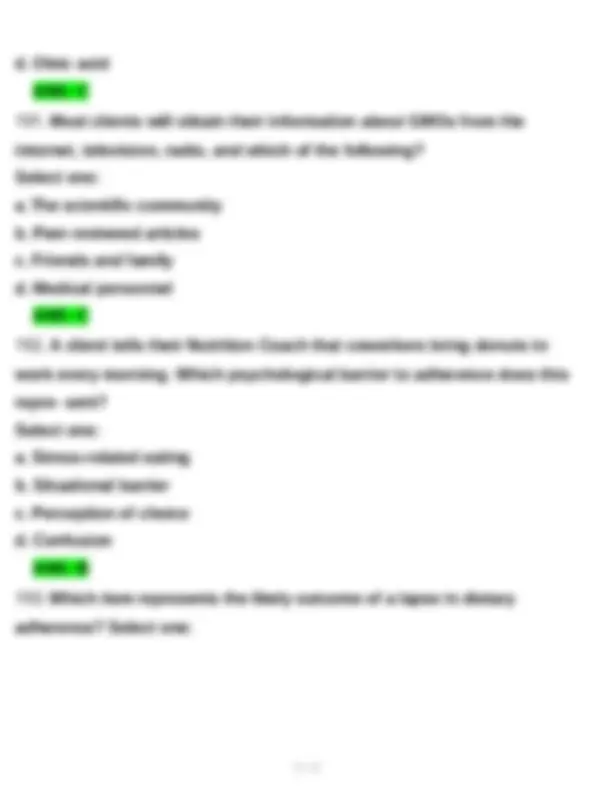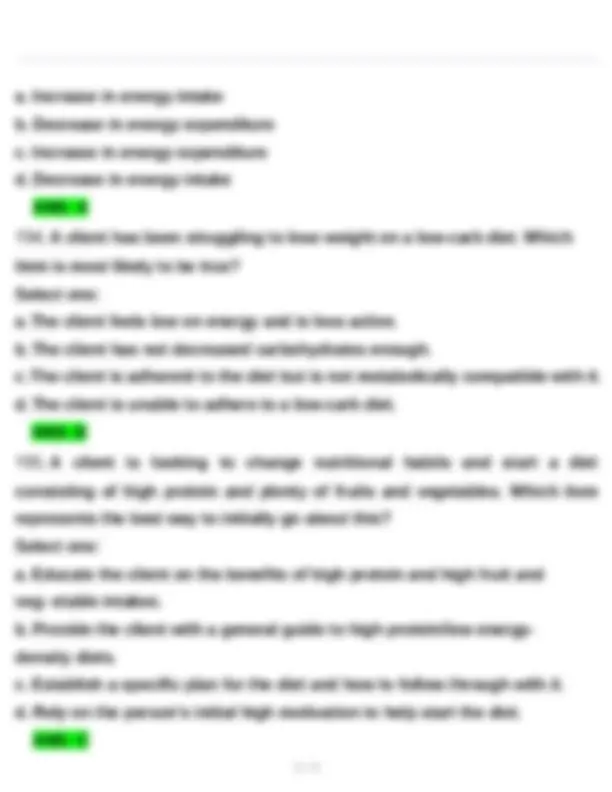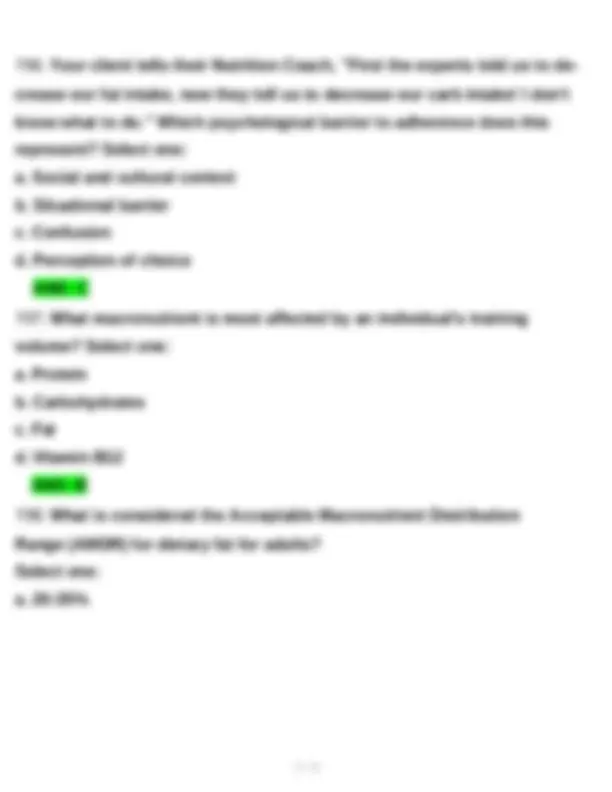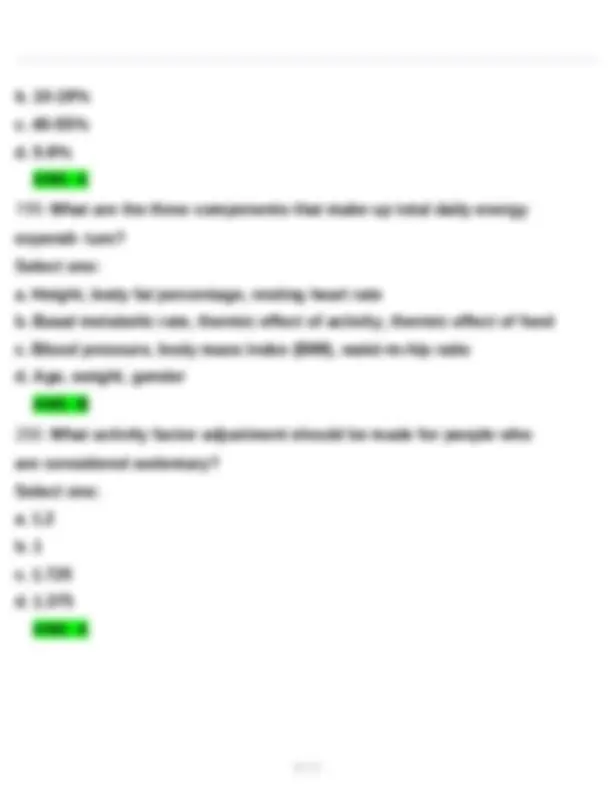Download NASM Nutrition Coaching Exam tested questions with revised correct answers, a+ guarantee and more Exams Nutrition in PDF only on Docsity!
NASM Nutrition Coaching Exam Questions and
Answers
- According to the scope of practice for a Nutrition Coach, which is an example of an appropriate resource for determining daily caloric intake? Select one: a. Dietary Guidelines for Americans b. ADA calculations based on age, gender, and activity level c. The Nutrition Coach cannot assist with daily caloric intake. d. Body type and cultural preferences ANS: A
- With which client would it be most appropriate for the Nutrition Coach to work? Select one: a. Pre-pubescent teenager who is overweight b. Overweight client who wants to train for a 10K c. Client who wants accountability during a 9-week extreme calorie- restricted diet d. Client who wants nutrition therapy for cancer prevention
ANS: B
- When working with a client who has been complaining of low back pain that has been getting worse, what is the most appropriate recommendation? Select one: a. Refer her to a certified personal trainer. b. Tell her to use a heating pad when the pain gets bad. c. Refer her to a chiropractor. d. Recommend use of over-the-counter anti-inflammatory medications . ANS: C
- Common assessments performed by a Nutrition Coach include height, weight, body composition, and what other test? Select one: a. Anthropometric measurements b. SCOFF test c. Blood pressure d. Hydrostatic weighing ANS: A
What is the appropriate response regarding the hypothesis? Select one: a. The predictions have been falsified and the hypothesis is discarded. b. The predictions have been confirmed but the hypothesis is discarded. c. The predictions have been falsified but the hypothesis is upheld. d. The hypothesis should continue to be tested . ANS: A
- Which term describes the phenomena when a group does not represent the population a scientist is intending to study? Select one: a. Generalizability b. Uncontrolled variable c. Recall bias d. Selection bias ANS: D
- Scientists gather 20 studies looking at the relationship between protein intake and lean body mass, and then they statistically analyze them together as a group. What type of study is this?
Select one: a. Observational research b. Randomized controlled trials c. Meta-analysis d. Narrative review ANS: C
- Which of the following represents a strength of observational studies? Select one: a. High degree of control b. Can determine mechanisms for effects c. Can establish cause and effect d. Large subject numbers ANS: D
- Which of the following is the technical term for body measurements and calculations as they refer to metrics related to human characteristics? Select one: a. Assessment b. Scaled c. Biometrics
c. Infectious diseases d. Chronic diseases ANS: D
- Which of the following is true about the link between type-2 diabetes and diet? Select one: a. They have a very strong connection. b. The link between them is very weak. c. It is proven and no longer studied d. It is not known. ANS: A
- What foods elicit faster satiety-signal responses? Select one: a. Fats and simple sugars b. Carbohydrates and proteins c. Water and simple sugars d. Processed foods and soda ANS: B
- The increase in energy expenditure after consuming a meal is referred to as which of the following? Select one:
a. Thermic effect of feeding (TEF) b. Non-exercise activity thermogenesis (NEAT) c. Thermic effect of activity (TEA) d. Resting metabolic rate (RMR) ANS: A
- Which hormone is referred to as the hunger hormone because it stimulates appetite, increases food intake, and promotes fat storage? Select one: a. Leptin b. Cholecystokinin c. NPY Neuropeptide Y d. Ghrelin ANS: D
- Calories or energy in = calories or energy out is an example of what principle? Select one: a. The first law of thermodynamics b. The second law of thermodynamics c. The fourth law of thermodynamics d. The third law of thermodynamics ANS: A
- What is the autoimmune disorder that leads to damage in the small intes- tine when gluten products are consumed? Select one:
d. A high-calorie, high-protein (1.8-2.2 g/kg body weight) diet & resistance training ANS: C
- Is post-workout protein consumption more important for novice or experi- enced weightlifters? Select one: a. Experienced b. Novice c. Post-workout protein is not important for experienced or novice weightlifters. d. Post-workout protein is important for both novice and experienced weightlifters. ANS: A
- What is the primary reason that plant proteins tend to make it more difficult to gain muscle compared to animal proteins? Select one: a. Plant proteins have more fiber. b. Plant proteins do not have as many essential amino acids.
c. Plant proteins are filled with phytoestrogens, which inhibit muscle gain. d. Plant proteins usually have anti-nutrition factors. ANS: B
- What are the essential amino acids? Select one: a. Histidine, lysine, methionine, proline, tyrosine, tryptophan, leucine, isoleucine, valine b. Histidine, lysine, methionine, phenylalanine, threonine, tryptophan, leucine, isoleucine, valine c. Histidine, lysine, methionine, phenylalanine, threonine, tryptophan, aspartic acid, glutamic acid, serine d. Histidine, lysine, methionine, proline, aspartic acid, carnosine, leucine, isoleucine, valine ANS: B
- The acidic chyme leaving the stomach must be neutralized before any digestion can occur in the small intestine. What compound neutralizes this chyme? Select one: a. Chymotrypsin b. Potassium citrate c. Pepsinogen d. Sodium bicarbonate ANS: D
- When would the body undergo the process of
b. Maltose c. Sucrose d. Glucose ANS: D
- What is the current daily fiber intake recommendation for women in the U.S.? Select one: a. 15 grams of fiber daily b. 30 grams of fiber daily c. 25 grams of fiber daily d. 20 grams of fiber daily ANS: C
- A client visits a Nutrition Coach for the first time, and tells the coach she is consuming 20% of her calories from dietary fat and 15% of her calories from saturated fat. What advice should the Nutrition Coach give the client? Select one: a. Recommend the client decrease total fat to less than 10% of total calorie intake. b. Recommend the client consume more dietary fat to evoke ketosis. c. Recommend the client consume more saturated fat to improve LDL choles- terol levels. d. Recommend the client decrease saturated fat to less than 10 - 11% of total calorie intake. ANS: D
- What is the function of low-density lipoproteins? Select one: a. Transportation of cholesterol to the small intestine. b. Transportation of bile to the gall bladder. c. Transportation of enzymes to the pancreas. d. Transportation of cholesterol to cells of the body. ANS: D
- What is the role of lipoprotein lipase? Select one: a. It is the enzyme that reassembles fatty acids into chylomicrons. b. It is the enzyme that breaks down triglycerides into fatty acids and glycerol. c. It is the enzyme that reassembles fatty acids into triglycerides. d. It is the enzyme within a person's saliva that initially breaks down food. ANS: B
- What are both chylomicrons and very low-density lipoproteins responsible for transporting in the bloodstream? Select one: a. Ketone bodies b. Amino acids
d. Brings about positive health benefits ANS: A
- What are the likely effects of consuming alcohol prior to going to sleep? Select one: a. Increased non-REM sleep and decreased growth hormone secretion b. No change to sleep patterns or hormone secretion c. Increase in REM sleep and increase in growth hormone secretion d. Decreased non-REM sleep and decreased growth hormone secretion ANS: A
- According to the Dietary Guidelines for Americans, how many standard drinks per day are recommended for females to ensure that alcohol consump- tion is moderate? Select one: a. Three b. One c. Four d. Two ANS: B
- What disease is the result of vitamin D deficiency? Select one: a. Rickets
b. Hypothyroidism c. Type 2 diabetes d. Psoriasis ANS: A
- What feature of minerals makes them different from vitamins? Select one: a. They can't be manufactured by the body in sufficient quantities. b. They help with metabolic processes. c. They are needed in greater quantities. d. They are inorganic. ANS: D
- Choline is the primary molecule used to make what neurotransmitter? Select one: a. Dopamine b. Serotonin c. Oxytocin d. Acetylcholine ANS: D
- What medical therapy is used to remove metals from the body, specifically things like iron, mercury, arsenic, and/or lead? Select one: a. Ultrasound b. Chemotherapy c. Chelation
d. "Your workout sessions are not long enough in duration to cause sweat losses that dictate a personal hydration plan. Keep fluids available during exercise, and drink based on thirst." ANS: D
- A client's pre-exercise weight is 75.0 kg. Their post-exercise weight is 73.5 kg. They consumed 0.25 liters of fluid during training. What was the volume of their sweat loss? Select one: a. 2.0 liters b. 1.5 liters c. 1.75 liters d. 1.25 liters ANS: C
- A client who trains for triathlons has asked how much fluid he should con- sume between his morning runs and afternoon bike rides. He has determined his sweat losses from his early morning runs average around 2 liters. Which range of fluid intake would be most appropriate? Select one: a. 1.5-2.0 liters b. 2.5-3.0 liters c. 1.0-1.5 liters d. 3.0-3.5 liters ANS: B
- How many hours does a protein-rich food need to digest or leave the
gut? Select one: a. Up to 5-6 hours b. Up to 1-2 hours c. Up to 7-8 hours d. Up to 3-4 hours ANS: D
- What does the Institute of Medicine recommend for protein intake? Select one: a. 40-50% of total energy b. 55-65% of total energy c. 70-85% of total energy d. 10-35% of total energy ANS: D
- What season is best suited for an athlete to attempt to lose weight or gain muscle? Select one: a. Pre-season b. Off-season c. In-season d. Post-season ANS: B

